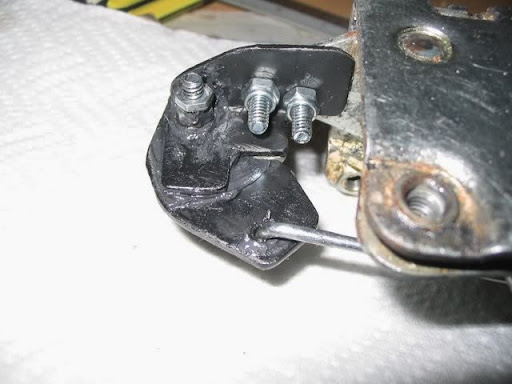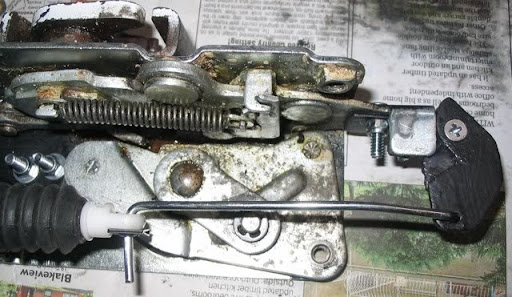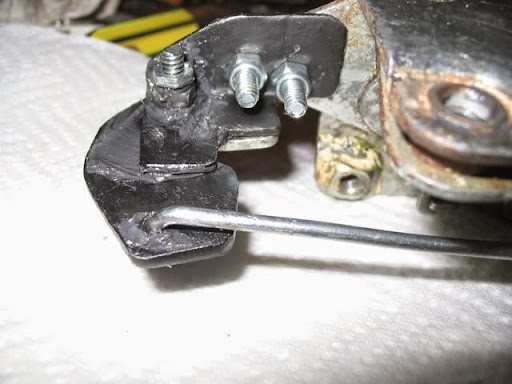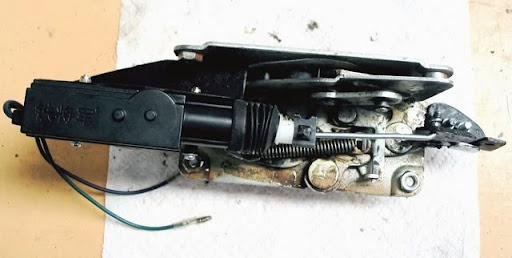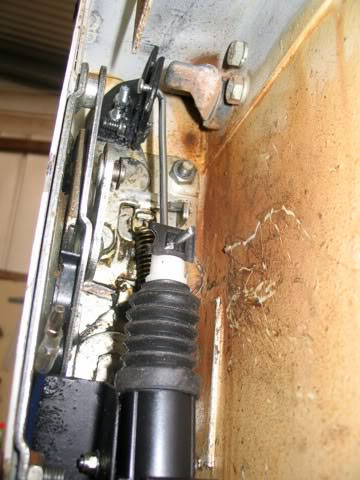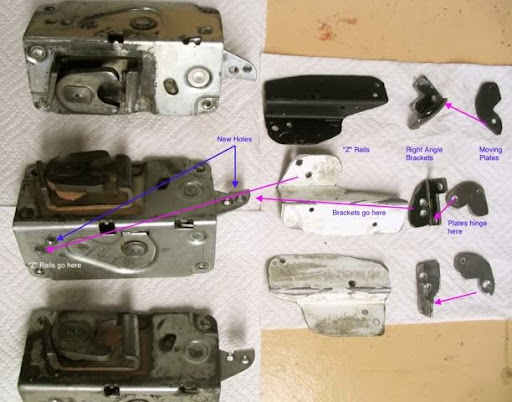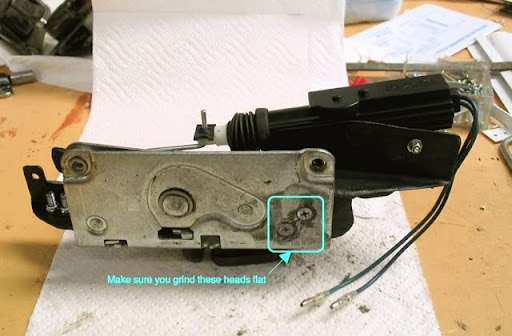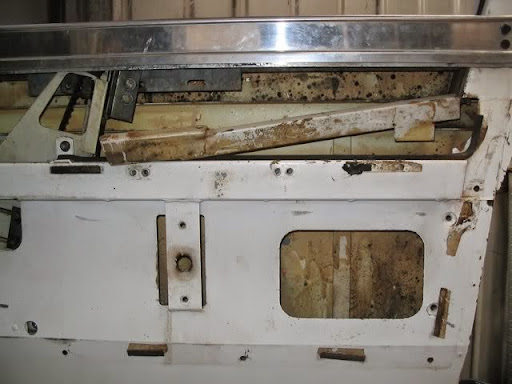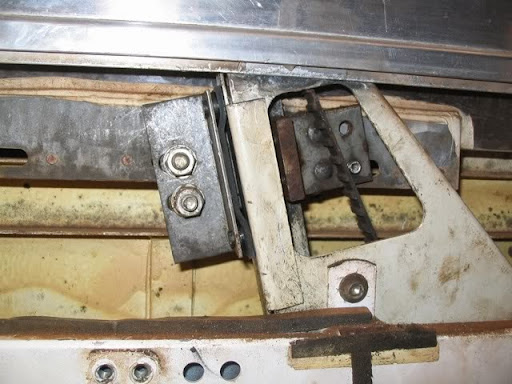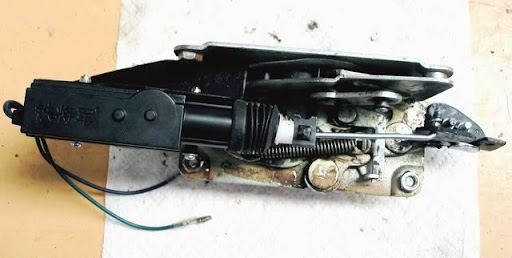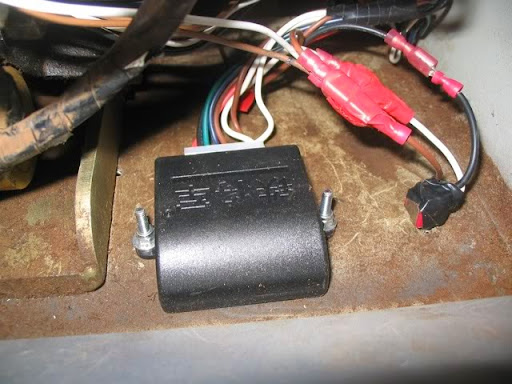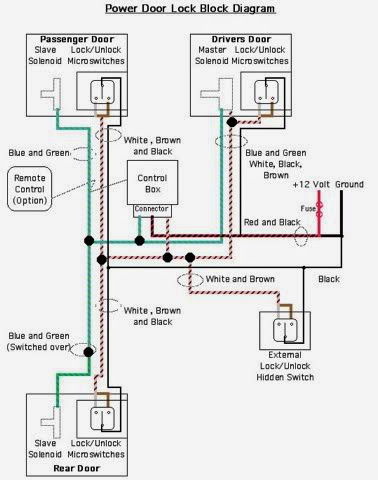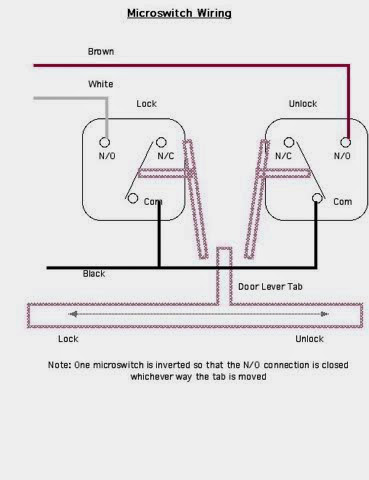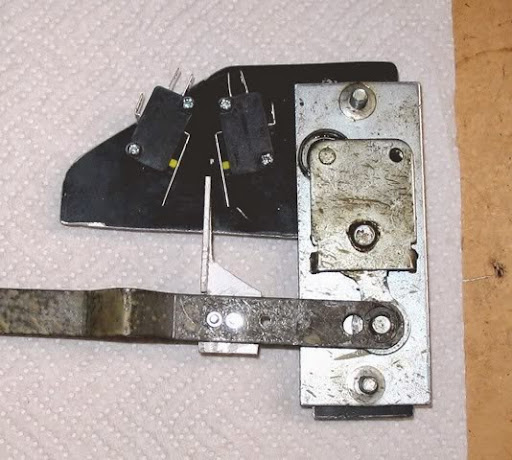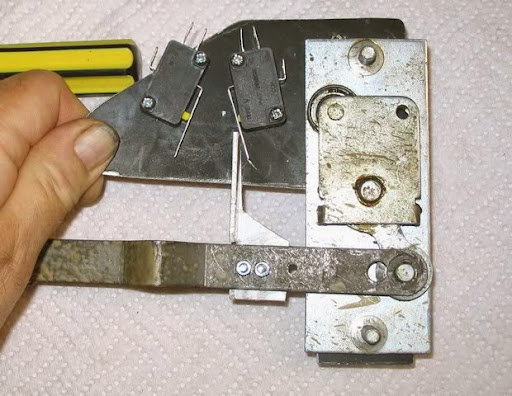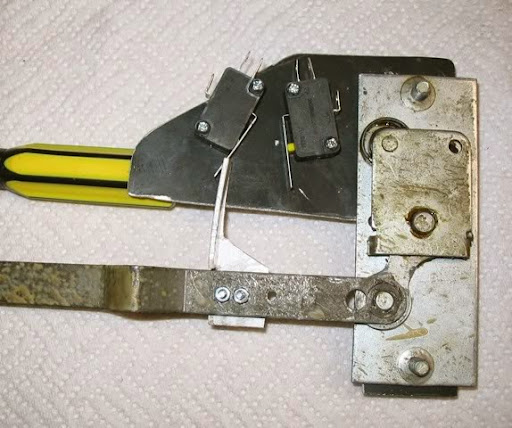Played by the Playford Pioneers (including me on the tenor sax), 15 May 2015
Category Uncategorized
Darwin to Adelaide
25 Aug
We are at the Manbulloo campsite in Katherine planning our trip up to Darwin before starting the long journey home.
Had a lazy morning so far, managed to access the internet for what to do in Darwin that we haven’t already done.
A day trip to the Tiwi Islands seemed like a good idea but when I searched for info all I got were confusing and misleading stuff about Aboriginal Tours (the only kind you can get and need a permit to visit anyway), and nowhere to book an economical tour ($250 by ferry or $450 by air, each) either. So I looked at Trip Advisor and all the comments were negative, waste of a day, no culture (no dancing, no art sites, no scenery etc), all time spent in one arts place, childish paintings, expensive arts, money, money, money etc and basically waste of time and money.
So that’s off the agenda, in favour of a $30 per 24 hours hop on-hop off double decker bus tour. It got tons of good reviews, even though we’ve done most of the places before, not having to drive, park, walk about in the heat seems a more and more attractive option.
In the afternoon we went shopping in Katherine for food, fuel and gas, all successfully, plus Janet bought some shorts in Rockmans as she always does. It was stinking hot but the counter girl in Rockmans was wearing jeans, a long jumper and a woolly scarf and still complained of feeling cold. Must have had hypothermia or ebola or something else exotic.
26 Aug
In the cool of the morning I did a spot of maintenance, checked the gearbox and transfer case oil, all OK, and greased the rear drive shaft UJs.
In the late morning we set off north stopping for lunch at Pine Creek and then a leg stretch at Adelaide River.
We had decided not to reach Darwin tonight as it’s a long hot drive and fighting the Darwin traffic to find a camping place would be hard to bare. So we spied a camping area at the Manton Dam Wall, officially a picnic area, about 70km short of Darwin and stopped here. It was a bit noisy but there were a few other campers here, some more happy with the arrangements than others:
So it wasn’t too bad and we cooked and ate outside since it’s darn hot (mid 30’s during the day and it doesn’t cool off much until the early hours).
27 Aug
Not a good day in Darwin, which is a pity since our previous visits have been very relaxing and friendly.
The drive up wasn’t too bad, 70km over fairly good roads, choked with road trains though, and ended up on a big freeway right into the city centre. We diverted to the waterfront, an area we hadn’t explored much before and stopped on Stokes Hill Wharf for a look at the sea. It’s a bit like a mini Glenelg with lots of eateries and a few souvenir shops. The menus make interesting reading but how can you be sure you’re really getting a camel burger and not a piece of horse meat?
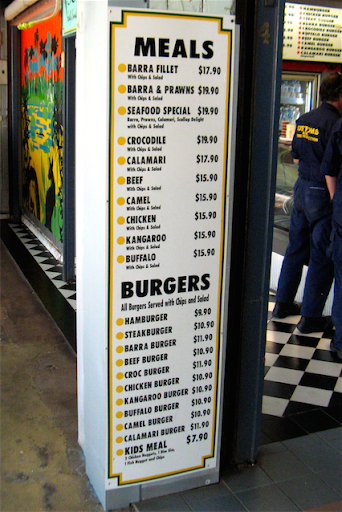
Nearby in a small park were a pair of stone curlews nesting. Their habit is to freeze when alarmed which makes them easy to photograph but also easy prey for dingos and raptors:
But mostly Stokes Hill Wharf was good because it has free parking. Make a note of that, it’s now the only place in the city where that’s still possible.
Fishing restrictions:
Interesting news from the NT:
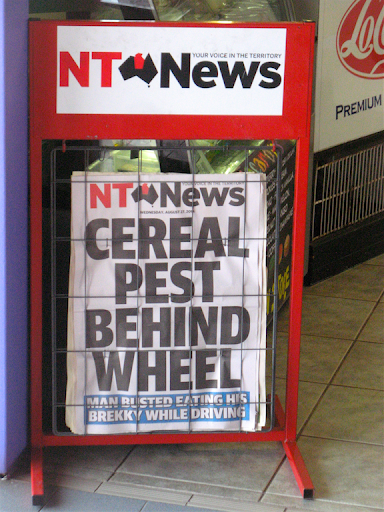
From there we drove up to the Esplanade, the main touristy section of park lands along the foreshore and opposite the parliament buildings, and all looked much the same except for the plethora of blue parking pay machines which now smother the city at around 10m intervals, and at $2.40 an hour (no notes or 5c pieces) it’s no longer the welcoming place for visitors it used to be. On our last trip this area had free visitor parking. We tried visiting the visitor centre to find out what else had changed but there was nowhere to park there either. In frustration we headed north to the East Point Military Reserve where there are excellent free car parks and good walking tracks along the cliff tops with plenty of memorabilia to visit too.
Later we trundled though the busy traffic and hectic road works to Lee Point where we had camped in the caravan park there quite economically before. But horror of horrors, it’s now charging $50 per night for an unpowered site. I remonstrated that it was a ridiculous cost for a patch of land for a night and twice the price we had paid in Katherine only 2 days ago but we were told, “well you could drive out of the city and park on the road side somewhere”. So I explained the lady how to clinically dispose of her offer and we did drive out of town, and saved $50 in doing so, along with quite a few other travellers. On the way we called another CP and was told the same story, $50 a night, and more for a powered site.
Strike me lucky!, Darwin has priced itself out of the Value for Money criteria. Worse than that, fuel is 10-15c a litre more than in Katherine (and there’s a lot more competition here), and the whole of Darwin is undergoing rampant development with industrial and housing estates now going up in every spare hectare of land across the city. This makes it a hot, dry, dusty as well as frustrating place to be.
There are no RV friendly facilities in Darwin, as there are now in many other towns and cities, and the government has failed to grasp the economic benefits of the huge number of self sufficient wealthy travelling nomads. By way of example these signs have sprung up all over Darwin:
Given that tourism sustains the economics of the NT, it’s very surprising and sad that they are paying scant regard to the needs of tourists, to the point that we won’t be spending any of our tourist dollars in Darwin anymore, and we have heard the same story from other travellers. Presumably their eyes and cash registers are firmly pointed in the direction of China, and bugger the rest of us.
We did think Broome would be the economic low point of our trip but Darwin has firmly taken the lead, by a long way. Broome was actually very affordable as well as being a lot nicer, freer and more relaxing.
We stayed in the same place for several more nights, the slight inconvenience and addition fuel costs far outweighing the $250 in camping cost we’d otherwise have incurred.
28 Aug
Well I feel a bit better today. After a late start caused by talking for too long to a lonely old fellow in a small Winnebago (who had formed the same opinion of Darwin as we had), we drove back into Darwin and “lunched” on the Stokes Hill Wharf.
There are lot of plaques around commemorating the first bombing raids by the Japanese in February 1942 which killed around 300 people in the docks area and sunk 21 ships…
So it was a bit ironic to see a Japanese naval ship tied up alongside RAN ships on the wharf.
This is our outdoor cinema day, which I’d booked up earlier, so in the afternoon we awaited darkness by revisiting the MAGNT (Museum and Art Gallery of NT) which is icy cold inside and free and quite good. It still has the same exhibits as on our previous visit, the Cyclone Tracy exhibit, which is very good, and a wildlife section and a lot of indigenous artworks and some from the SA Asia region.
We pottered along past Mindl Beach which they were setting up for the sunset markets and back to the cinema carpark which (as all parking areas are in Darwin) is mercifully free after 5pm, Saturday arvos and all day Sunday.
The Deckchair Cinema is a 50 year old, volunteer-run, not-for-profit Darwin tradition. The earlier Star Theatre was destroyed by cyclone Tracy and replaced by the current outdoor theatre at the waters edge beneath the Esplanade. It’s surrounded by palm trees and shrubs to give it a sheltered aspect.
The deckchairs are metal and canvas affairs (they do provide cushions, plus we took our own), similar to the Sun Picture Theatre in Broome.
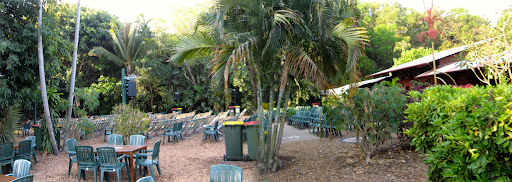
Meals, (like a “help-yourself BBQ” and which are provided each day by a separate fund-raising charity) and drinks can be bought and eaten at tables prior to the movie, or in your deckchair if you’re careful.
Films change every day and the film we saw was “Tracks”, a new all Australian movie recounting Robyn Davidson’s 8 month solo trek (with 4 camels and dog) across the western deserts of Australia from Alice Springs to the Indian Ocean in 1977. Her story was published in National Geographic in 1978. We don’t know why it took 35 years to turn into a movie but it was very well done.
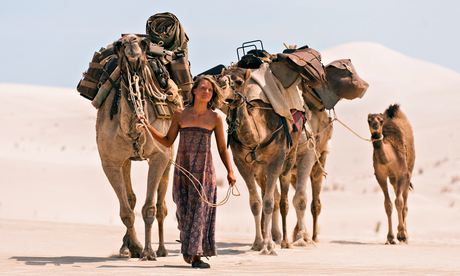
Since we had done almost the same trip last year from Alice Springs via Docker River and Warburton and along the Gunbarrel Highway right out to Steep Pinot on the west coast, it was quite meaningful and familiar, although quite a lot of cinematic licence was taken with locations (it was all shot in SA and the NT), the scenery, the story and her obvious love of her camels and dog Diggity was extremely effective. It does have some sad moments but overall a good experience in a very different movie environment. It got cool but not cold and there were a few external distractions, like a ship passing by with lights blazing, and a few mossies, but it was a good night out for $12 each. See the trailer here.
Late at night we drove back to our Manton Dam campsite in the dark and along the way called Scott who is leaving for his European adventure/honeymoon on Saturday, meeting up with Tash who’s on a business trip in Croatia. It was the usual long call and halfway through our credit ran out, so he called back and then the signal disappeared as we drove out of range. But by then all had been said that needed to be said, and more.
29 Aug
Instead of traveling back into Darwin today, we (that is I) decided to divert up the Arnhem Highway to the Mary River NP for a couple of days where we knew we could get up close with large crocs, we’d been there before, in 2008. Then we could head back to Darwin on Sunday, refuel or what ever, visit the Mindl Beach markets in the late afternoon and make our exit from Darwin and head south.
However the Arnhem Highway is not the nice country drive it used to be, for a start the sides of the road are infected by commercial advertising signs for everything from Water Tanks to Bottl-O’s to Dig Your Own Power Pole Holes, second there are a plethora or 3 of road trains and army vehicles roaring down a not very wide road.
We stopped for lunch at Fogg Dam reserve, built in the early 1900’s as a rice growing area for export to SE Asia, but failed to survive due the Asian’s developing their own rice industry.
This heron had caught something but it didn’t look very fish like, maybe a small eel:
Janet on a hot forest walk:

We are camped in the Mary River NP at Couzens Lookout, a free campsite overlooking a large billabong in the Mary River.
It was hot so we sat outside in the evening computing:
30 Aug
There is a lot of wildlife here (but fortunately no other campers), kangaroos, noisy kookaburra’s, cape barren geese, pheasant coucals (see pic).
And a cormorant drying its wings
Under the Oka this morning is a pool of fluid, fortunately only radiator coolant. There’s been a drip from the thermostat housing for some time but now it’s worse so now it needs a new gasket, which I’ve got a spare one of. When the engine is hot the leak seems to subside so it’s not as bad as it looks. It’s only lost less than 2 litres of water so I can top that up daily.
But to make things easier I’ll leave replacing it until we are at a more civilised location lest something serious goes wrong which I can’t fix here, a small leak is better than an avalanche, and replace the gasket in Darwin or Katherine in a few days where help is nearby if needed.
Off to look for crocs this morning and we’ll return here tonight.
So we looked around the Mary River here at the lookout but there had been a lot bigger wet season than the last time we were here and the river level is a lot higher and there were no river flats for crocs to lie on.
We headed north and stopped off at Mistake Billabong for a lunch and look for wild animals but on the walk in it was me that made a mistake. There was a bitey fly buzzing around my head so I snapped off a small leafy eucalyptus branch as you do, for use as a fly whisk. Unbeknown to me green ants had constructed a nest on the branch, made of leaves bent over and glued along the edges, and they don’t like being disturbed, especially if being used as a fly whisk.
After a couple of waves of my whisk the bitey fly was quickly forgotten as I was covered in bitey green ants instead, inside and outside my shirt and up my shorts and all over the camera case I was carrying. I had to strip off and remove each of the hundreds of ants one at a time as they bit me, the camera case, my shirt and ultimately Janet who came to my rescue. It took a good 5 minutes but fortunately the bites are not venomous or long lasting, just annoying.
These are the little blighters:
And instead of dangerous crocs we saw a feral water buffalo. These creatures can also be dangerous but this one was on the other side of the billabong. I thought they had been almost eradicated in the NT, Crocodile Dundee style, since they cause so much damage to waterways, but obviously not.
After lunch we drove north to Shady Lagoon, where we knew from past experience is where to find crocs, lots of crocs, and we were’t disappointed.
At the viewing platform we could see at least 8 or 9 crocs sunning themselves at various places on the far bank, and a few more cruising around just beneath the surface.
It was at this very spot that in 2007 I dropped 2 rechargeable batteries through this grille on to the mud as I was changing them. Sadly they are no longer there but just like last time, I wasn’t intending to brave the croc river to retrieve them.
A while later we spied a large croc, probably 4-5m long and weighing 500kg, heading slowly towards the nearby boat ramp so we went round to check it out.
It cautiously approached the ramp, just like we did.
I walked tentatively towards him to about 10m away and he heaved himself a bit further on to the ramp and watched me. I bravely and sensibly backed away a bit.
Look at those interlocking teeth (which they are born/hatched with) with 10 tonnes per sq inch of crushing power.
We watched him (or her) for 10 minutes or so and he was definitely eyeing me up as a potential feed. I was a good 10m away up the ramp, but he obviously knew the boat ramp meant a potential meal, and this is probably why, at the very same spot. People are advised not to enter the water when launching boats, which this fellow did.
After we moved on he slid back into the river, a sure sign that we meant something to him. Perhaps he just wanted to be my friend?
Actually these are extremely dangerous creatures, they are Australia’s number one predator and not to be messed with. More people are killed by crocs each year than by snakes and sharks combined. The may look slow and fat out of the water but they can move at lightning speed when they want to, we witnessed that on our last visit when we surprised a croc laying on the bank. It surprised us too….
There’s a law in the NT prohibiting boats from approaching within 10m of a croc, and the same common sense applies to foot traffic too. While you’re focussed on one croc, another could be creeping up behind you…
Subsequently we went to Mindl Beach markets in Darwin where a young lady from the Crocodylus Park (where you can take home a “Crocodile BBQ Pack”) was showing off a small one year old hatchling, which Janet had a hold of (the young lady wasn’t allowed to let go of the croc as some people have be known to run off with them):
Actually they feel like a cold sausage, but all smooth on their underside (the valuable part, aren’t they all?). If it was in the wild, this one could have grown as large as our Mary River specimen (even at one year old it could snap your finger off, their jaw muscles have a mechanical leverage mechanism like bolt cutters). But sadly this one will have long since become handbags and shoes.
That night I invented a better way to keep my beer cool between sips, using second stubby cooler as a lid. Worked pretty well.
31 Aug
Today we left our Couzens Lookout camp on the Mary River and headed 140km back for a last look around Darwin before departing south.
We “lunched” on the Esplanade where parking is free on Sundays, and walked around the many military memorials along the shady grasslands on the top of the cliff overlooking Darwin Harbour. Commemorative wartime plaques are still being erected there, the latest being in 2012 in memory of Canadian Signals and Communications forces who operated here in the latter stages of the war.
This the memorial to the USS Peary, sunk with the loss of 91 sailors during the first Japanese bombing raid on Darwin on 19 Feb 1942, the first ever raid on Australian Soil (other than the European invasion of 1788). At that time invasion was far from expected and there were only 2 fighters (US Kittyhawks) to protect the whole of northern Australia. They were both destroyed on convoy protection and their pilots were lost, but due to a news blackout of the raids, the bravery and sacrifices of the defenders was never disclosed or commemorated until after the war. Neither was the plan disclosed to abandon the northern half of Australia in the event of full scale invasion and defend only across the Brisbane-Alice Springs-Port Hedland line, roughly across the 23rd parallel.
Over the next 3 years a large number is airstrips and military facilities were constructed in WA and the NT and particularly around Darwin and many can still be visited although sadly some are now on private land and only informative plaques remain. A pity because they are useful camping areas where you can immerse yourself in history. Just recently the site of the secret Z Force commando regiment, whose exploits have never been fully disclosed to this day, was ploughed up for an industrial site. The NT Govt considered a plaque was all that was needed.
We paddled in the sea off Mindl Beach so technically we’ve been in the sea in Darwin, something you are not supposed to do due to deadly crocs, jelly fish, sharks, cone shells etc. but we did paddle between the flags.
We mingled with all the young and beautiful people in Mindl Beach markets where we sampled spring rolls and a fruit salad and Janet bought some more earrings, as normal.
But there were a few new stall types:
Eco-Nappies. Actual cloth nappies you don’t have to throw away. Well who’d have thought of that? But they do come in colours other than white.
And the iSmashed.com stall where you can have your broken iPhone screen replaced in 30 mins for only $149. 2 guys twiddling miniature screwdrivers on microscopic screws from a magnetic pad, but there’s probably more to it than that.
Halfway through, everyone departed over the sand dune to the beach and just sat there looking.
At this, more photons from outer space. Moisture and smoke which hangs in the Darwin air always causes spectacularly colourful photons:
Our last Darwin sunset, for a while:
After the ball was over we drove back to our our Manton Dam Campsite for the night, which is on the way to Litchfield NP anyway.
We’d spent 6 days in the Darwin area at a camping cost of $0, but it did cost around $50 in additional fuel costs. So we had an extra $200 to spend on other things.
|
There are still good things to see and do in Darwin that don’t cost a fortune, but caravan parks and street parking are not ones of them. |
When we got to know the new Darwin a bit better there are still lots of good things to see and do there. We liked:
- Stokes Hill Wharf,
- The Esplanade,
- The Deckchair Cinema,
- The Museum and Art Gallery,
- East Point Military Reserve,
- Coolalinga Shopping Centre,
- The Mindl Beach Markets and
- Cullen Bay.
On previous trips we also enjoyed:
- The Aviation Heritage Museum,
- Casuarina Shopping Centre,
- The drive out to Gunn Point and Fright Point,
- Fannie Bay beach,
- The ferry to Mandorah or
- The drive around from Darwin to Mandorah to visit the 1945 Milady Liberator crash site.
1 Sept
This morning we took the Old Bynoe Road west to the Litchfield Park road to cut off the corner. It was so old some of it has disappeared and we had to do a bit of skilful navigating to get on the correct road.
We stopped to lower the tyre pressures for the 40km or so of gravel on the back road to Litchfield since it was a lot more corrugated than we recall from previous trips.
We called in at a couple of sites where magnetic termite mounds had been built, flat on the east/west side and thin on the north/south side to minimise the heat from the sun.
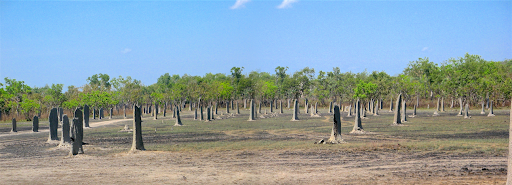
We checked one out and it was built exactly magnetic N/S within a degree or 2, to minimise solar heating. Moreover, the mounds were slightly curved, and leaned towards the west to further minimise solar radiation since the sun is more powerful later in the day. Damn clever these termites.
Photo taken at 10.30am. By noon the mound would be almost exactly in line with the sun.
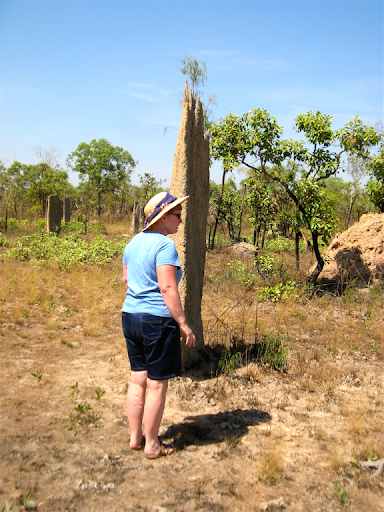
Further on we stopped for lunch at Walkers Creek where Janet dangled her toes in the creek.
We arrived at the Wangi Falls campground in the early afternoon (only $6.60 each and excellent facilities, plus a pretty good water feature out the back), but by then it was fiercely hot, so a quick swim in the pool was called for.
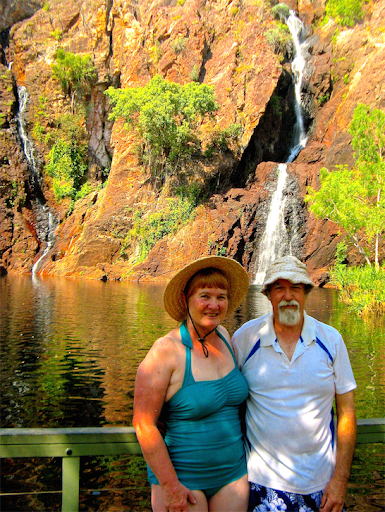
Me relaxing in the warm water:
In the wet season the whole of this rock face would be covered in a raging torrent and hidden by spray (I’ve seen the photos), but it’s comforting that the park authorities are fairly certain there are no salties in the pool now (like there was last year and they had to close the pool for swimming, 3 weeks after they declared it free of salties). But they still maintain crocodile traps in the creeks.
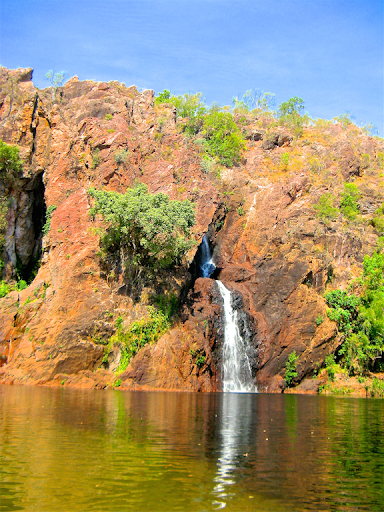
Flying Foxes (fruit bats) were roosting in the trees around the pool.
After our swim we had a $5 ice cream from the kiosk and chatted to a girl from Finland who was working there. She’d only been in Oz for a couple of months and was feeling the heat. She was cleaning out a freezer cabinet so we said “Why don’t you jump in it, you’ll feel at home?”. We repaired to the Oka for a cold beer since it was way past I don’t care when and I needed a cold drink.
Bower birds mimicked and whirred their noisy songs all around us.
We had a nice tuna salad outside tonight since it was so hot, followed by strawberries and cr ème anglaise (custard) with red wine (since I’ve finished up all the white stuff), and we played our Farm Day music and reminisced about music practices. Maybe the bower birds will start mimicking our Farm Day music?
Just on dusk, thousands of flying foxes left their roost around the pool and made their way silently overhead to wherever they go to feed at night. Smaller bats flitted around below treetop height catching some, but definitely not all the bugs which were/are annoying us.
Whilst sitting out in the still of the evening, a black feral pig clomped and snuffling its way noisily passed our campsite looking for food scraps. There was an advisory notice about it on the way in and rangers have being trying to catch it. But we caught an image of the beast as it passed by our campsite for a second time. They are heavy creatures and can be dangerous if cornered.
2 Sept
We went for a morning swim in the falls again since it got quite hot quite early but it’s not as good as in the later afternoon. The sun casts shade over the falls and most of the lake, there are fewer people about and the water seems a bit cooler in the mornings.
After packing up we drove out to the highway and down a corrugated track to the Blyth Homestead. It was built as an outstation on the Stapleton Station in 1928 and housed 2 adults who eventually had 14 children there.
The mother schooled the children and was cook on the main property, the father who was fiercely independent, ran the rural aspects and the elder children ran the market gardens alongside the creek and a tin mine near the small homestead. It was a tough life and none of the children left the homestead or saw anyone else or knew what money was until their early 20’s, they just worked for their father almost as slaves and for no pay.
Mining tin was extremely hard work, they dug down 27 feet and then tunnelled outwards following the tin seam. Tin ore is heavy stuff, the large normal rock on the left weighs 22kg, the smaller lump of glittery tin ore in the centre weighs 43kg.
Then they had to break it up manually with large hammers, then pass it though several ore crushers and sluice the fine dust with water through hollowed out logs to sieve out the tin.
Still, their father had the right idea about useful scraps of old iron:
During the war they had a bit of excitement when a Japanese plane was shot down nearby and they got some useful info from it for the intelligence services.
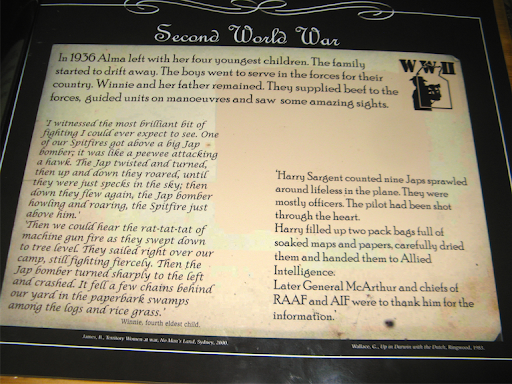
We had lunch at the homestead, which was much easier than mining tin, and then moved on to the Sandy Creek (Tjaynera) Falls for an afternoon swim.
However, there was a tough little 1.7km walk to the falls so we were pretty hot when we got there and the water was colder but more refreshing than Wangi Falls.
Janet taking a dip in the pool:
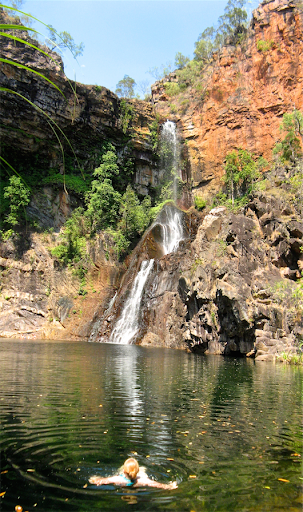
Since it was getting late we decided to camp here but it’s not the best campsite around, for the same cost as the Wangi Falls campsite there is no rubbish collection so there are bags of garbage all around and only one loo with a cold water shower. But it will do for one night.
3 Sept
Not such a good day today. Visited the Tolmer Falls but they weren’t that impressive with little water flowing over them.
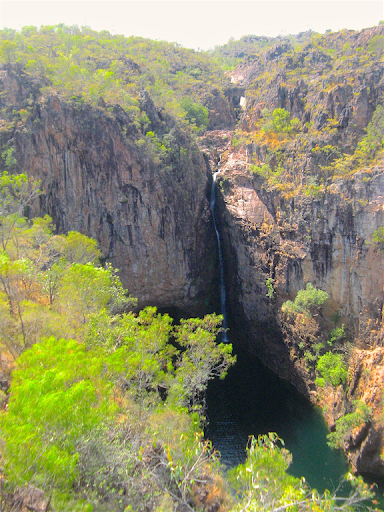
There is a nice rock arch though which water would come in the wet season with a substantial force.
We bypassed Buley Rockholes since there were a lot of tour busses in there and we’ve done it all before and headed out to Batchelor for lunch, and access to the internet for the first time in several days.
There was a message from Scott who had arrived in Split (Croatia) all OK and with Tash they’re starting their European vacation/honeymoon, so that was a positive.
After lunch we set out for some WW11 airstrips that we’d been to before for another look around and somewhere to stay. However I got extremely angry that they were now in private hands with locked and barred fences and gates so we couldn’t visit them anymore. So much for the NT government’s much proclaimed WW11 Heritage campaign. Their multi-coloured signboards still show Fenton Air Base as a W11 Heritage Site:

Fenton in particular was my favourite with a graveyard of broken and wrecked aircraft to fossick through and runways to drive down. Sadly this is a trend all over the NT with WW11 memorabilia being lost for ever.
And for good measure the countryside around here is shit as well, all burned out and looking terrible. Much the same all over the top end so no more top end for us for a while. We’ll stick to deserts. You can’t burn deserts.
With this frame of mind I wasn’t about to stay in any Big4 crapsite so we turned off the highway at Hayes Creek to an historic mining pub (Grove Hill Hotel) and are camped out the back for $Big4/3. Very outback as it happens with country style showers and loos in tin sheds.
And our wine stocks from Adelaide have finally run out after 6 weeks. I knew I should have filled another jerry can.
Tomorrow we’ll trundle down an historic mining area through the Bonnie Ranges to Pine Creek and thence to Edith Falls to camp.
4 Sept, my grandma would have been 132 today.
And down we trundled on a very smooth gravel road to Pine Creek and since we made such good time we carried on trundling to Edith Falls for lunch.
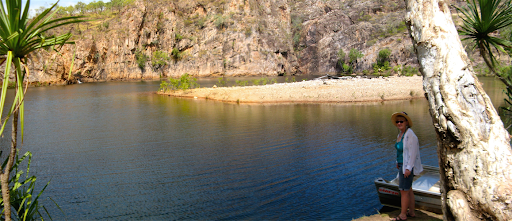
It’s quite a few years since we’ve been here and it’s quite nice so for $18 we are camping here for a swim or 2 in the pool. The falls have very little water flowing since we are getting towards the end of the dry season and a huge gravelly sandbar has emerged from the depths, swept up by wet season storms:
The water was cool and dark and you can imagine all sorts of creatures from the deep rising up to do unspeakable things to your appendages:
As it happens after my swim I was leaning on a bridge, as you do, looking at the Edith Creek:
When something caught my eye:
A crocodile trap had been subtly set up the creek. It’s either very encouraging or very worrying that they have to set up such things. At least it was empty, and that’s a good thing, I suppose.
There was a report in yesterday’s paper of a man being bitten by a fresh water croc only last month in Wangi Falls in Litchfield NP, where we were a few days ago. They had to close the swimming area while rangers caught and removed the offending creature. Last year they found a saltie in there too…
5 Sept
A cool night but there were a couple of small kangaroos with joeys feeding in the campground early this morning.
By 8 am the sun and the flies had both risen as we ate breakfast outside, rather quickly actually.
By 10.30 it was hot and we reached Katherine and sought out the laundromat. While the washing was well, washing, we went to refill a gas bottle. While the washing was drying we had lunch and when it was all folded and put away we headed for the supermarket for a week’s supplies and 220l of fuel.
Things I hate about Katherine (and many other places which do the same thing):
a) Having to pay to go to the loo in the shopping centre ($1).
b) Having to pay for a shopping trolley ($1 or $2 although you do get it back upon return of the trolley, but it’s still a drag).
c) Having to queue for 10 minutes to pay for groceries, when there are lots of empty checkouts. And the trashy magazines on the stands just make the time go even slower.
c) Having to pay for water at the visitors centre ($2 for 5 minutes on the hosepipe, easily 100 litres). Although we could have got it for free at the servo but it’s not so convenient.
[Interestingly, I spelled “ALthough” with a capital “AL” and the spell checker offered “Although” as an alternative obviously, but also “donut”. Why?]
Heading off down the highway we realised that we had missed out the bottle shop so our 1 can of beer and 2 cans of cider will have to last several days. Still, I did put a bottle of sherry in the fridge since sherry at 40º doesn’t have the same effect somehow. Might have to do the same with the port although we don’t seem to have much of that left now. We still have 1/2 a bottle of Serge’s red wine left which is also in the fridge. Is there a trend emerging here?
d) Having to wait until the bottle shops open in the afternoon and then only getting 1 or 2 litre casks at 5 litre cask prices, which we forgot anyway.
Camped tonight at the Leach Lagoon Rest Area, 50km SE of Katherine. However there is no sign of a lagoon here, which is tanto montare to misleading advertising.
6 Sept
One of our favourite swimming spots in all the world is Bitter Springs creek in Elsey National Park just 50km down from our campsite.
The water there is incredibly deep, clear and warm (33º all the year round) and it’s in a natural tropical wetlands area of pandanus and palm trees. Steps have been added to reduce erosion of the creek banks. Because the water is high in minerals and low in oxygen very few creature live in it making swimming a real pleasure, and it’s free.
Me lazing around in the warm water:
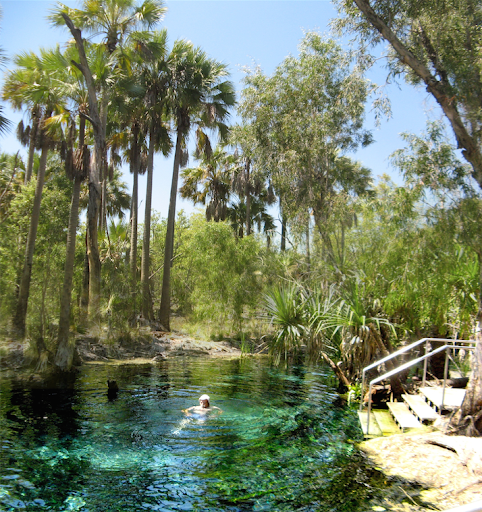
You can swim/drift about 100m along the creek through a primordial swamp to a bridge and exit point. Janet found it too warm for a long swim.
The palms here are the kind that dinosaurs fed on, in fact you can still see their bite marks on the leaves.

After lunch we checked our emails at Mataranka and turned east on the Roper Highway heading for the Limmen NP about 200km away near coast of the Gulf of Carpentaria.
The road is a single lane piece of bitumen which I find more annoying than all gravel roads as you are continually slowing down and putting 2 wheels in the dirt to pass other vehicles.
Anyway, 70km down is a nice rest area (Mt Price) with a large mountain of rock in the centre that you can hide behind and be protected from other campers (there were none) and traffic noise (of which there was none all night).
What there was however, was a pair of donkeys who put up a terrible racket for about 10 minutes while we were eating dinner outside in the dark and scared us sh*tless.
7 Sept, my LXIX birthday
This time last year we were at an Oka gathering in Harrismith, SE of Perth, and the weather was cold and wet. Today we had our hottest day on this trip so far, the external thermometer read 40.1º but it felt hotter than that in the Oka. Fortunately the a/c is working fairly well and there are several lily lagoons along the road which make things feel cooler even if they’re not.
We stopped off for a look at Roper Bar, a man-made concrete causeway across the Roper River. Nice and calm now but impassable in the wet season.
A family of Aboriginals were having a fun day out in the water which is safe to swim in around the causeway.
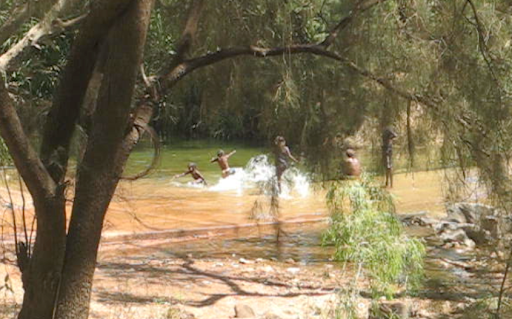
We stopped at a lagoon we had camped near before for lunch and to check our emails.
This area is not noted for it’s mobile coverage but just near here, on the other bank of the Roper River is the Aboriginal community of Ngukurr and we piggy backed on to their Telstra network.
I had the usual gaggle of birthday emails from all the websites I subscribe to plus one from Charles and Fred in the UK and a message from Scott who is in Rome and just as we were leaving a call from Alan. Soon after we were out of range again so apologies to those who might have sent messages but we’ll collect them when we are next in phone range, probably Tennant Creek in a few days time.
We passed by a number of brand new campgrounds in the NP, none of which had any campers in and made for St Vidgeons, the ruins of a former Lomarieum (don’t know what that is but it sounds serious if it has to be as isolated as this). The usual Aussie disregard for authority was evident:
The main attraction here however is the nearby huge lily filled lagoon with plenty of camping opportunities (but no swimming due to croc risk), so since it was so hot today and there’s a nice cool breeze blowing here, we are camped alongside it.

Water lily leaves with turned up edges:
Tall water lilies on the far side:
A duck in cunning disguise:
Relaxing in the cool breeze on a very hot 40º day:

We took memorial photos of the birthday drinks, dinner (tuna salad) and dessert, just as the sun was setting:
Dessert consisted of strawberries and yoghurt for Janet, and strawberries, custard and slices of Mars Bar (because it’s my birthday and they were my pressie) for me.
The sunset over the lagoon was pretty special too.
8 Sept
Today is Charles LXX birthday,
Happy birthday Charles, we celebrated your anniversary with an ice cold glass of sherry under a full moon on a warm evening in the Southern Lost City in Limmen National Park.
We left St Vidgeons still ignorant of the meaning of “Lomarieum” (the informative plaques had all been burnt out), and motored down the worsening track to the Towns River. There is an excellent campsite there and the river always looks beautiful and inviting…
From there to the Cox River Crossing the corrugations got worse so we stopped for lunch just past the crumbling causeway and 3 guys (1 English from Guildford and 2 Germans) in a petrol Pajero with no A/C pulled up and asked if they were still on the Savannah Way. Well there’s only one road in the area so we are all on it.

They were heading for Cairns but only had a flimsy paper map and were amazed at our moving map system. We had a chat for while about the availability of LPG in Borroloola and it seemed to us they were ill prepared for such a trip, one of the roughest tracks across the top of Australia, we’ve done it several times. Still, they were young and nothing much worried them.
The Cox River where they were going to do some fishing.

On the way further south, we came across these confusing signs:
It turns out we were crossing a mining company haul road from/to an iron ore mine. But this is in the middle of a National Park! What is happening in the NT? This is not the first time we’ve come across this on this trip (there are new mine sites all along the Roper Highway and there has been a uranium mine in Kakadu National Park for many years) and they seem to be putting economics ahead of any environmental considerations.
We called in at Butterfly Springs where we have swum before (the only place where it’s safe to do so) but this year the pool is almost dried up and the waterfall has long since stopped flowing.
There was a water monitor clinging to the side of the rock sunning himself:
We are camped tonight at the Southern Lost City, an amazing place of crazy leaning rock formations which we’ll have a look around early tomorrow morning before it gets too hot.
9 Sept
We did our morning walk and most of the area had been burnt out. However that was a bit different and allowed a better view of the rock formations.

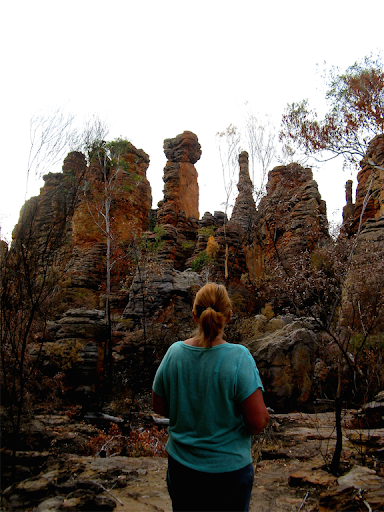
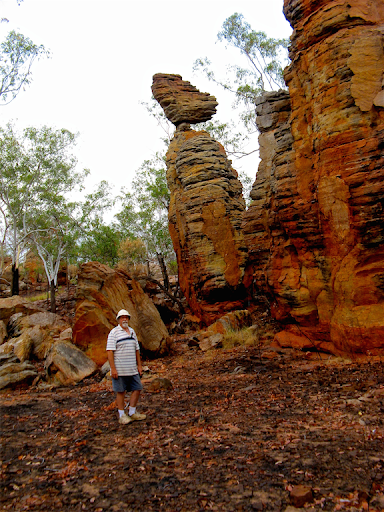
After our 7am walk, the clouds were burned away by the sun and it started getting very hot so a shower was called for. The wire in the large antenna got very tangled up as I was lowering it and I couldn’t get it apart in the hot morning sun so I left it until later to sort out.
Then the A/C stopped working on the way down the track so we stopped to fix it at Batten Creek. The compressor fuse blew and a few minutes after I replaced it the replacement also blew.
I confirmed that the compressor was working OK and found that one of the connections on the pressure switch on the front condenser was causing the problem (something on that other wire was dragging the voltage down from 12 to 9 so it’s a heavy current partial short circuit which slowly blows the 30A fuse) but not the additional fan I had fitted, so I replaced the cable from the switch to the compressor and all was OK again, I thought, so we had lunch.
The original evaporator fans wasn’t working on that circuit so I assumed that might have been the problem but possibly not. A few minutes later the rear A/C didn’t seem to be working indicating that the solenoid allowing cooling fluid to the rear evaporator wasn’t functioning and then the rear fans stopped working as well presumably a fuse problem too, but maybe a thermal cutout issue since it was OK the next morning.
Rather than buggerise around any more we carried on using the front A/C only and one condenser fan, which was just up to the job, and I’ll investigate further tomorrow in the cool of the morning.
The Nathan River Road through the Limmen NP got gradually and very frustratingly rough and corrugated as we drove south and we could barely manage 30kph. And there were quite a few creek crossings and causeways to negotiate.
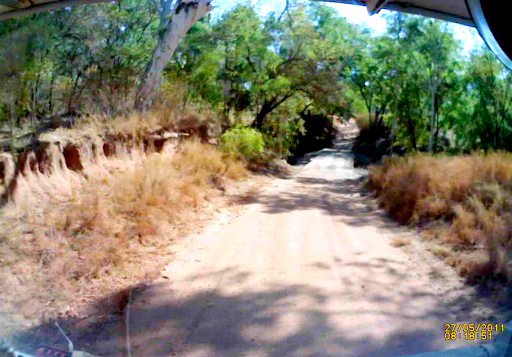
When we got to what I thought was the Carpentaria Highway and a bitumen road, I was sadly 50km out of place and it took another hour to reach the relative comfort of the Cape Crawford Road and Tablelands Highway.
These are sealed roads but only a single lane and very undulating to the point of seasickness. Eventually after 2 hours of lonely driving though reasonably attractive cattle country and “hill covered trees”*, we reached a rest area only to find several other caravans already here, but here we will stay after a long gruelling day in the saddle. This road, although sealed, is very rough and narrow and not really suited to caravans. It’s also nearly 400km between fuel stops.
* Janet didn’t see anything wrong with this statement.
There was a nice looking big windmill along side the rest area with a water tank.
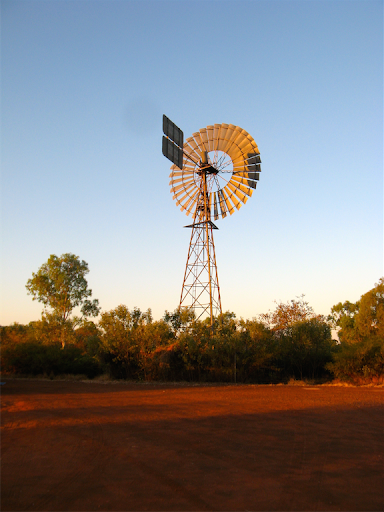
We sat outside but the cicadas were absolutely deafening, like severe tinnitus turned up 100dB.
10 Sept
The “nice looking” windmill woke us up several times in the night with it’s screeching and rattling as the breeze varied from nothing to light.
Fairly uneventful today if you exclude the indicators which stopped working. That turned out to be a fuse with dirty connections which I refitted yesterday. A quick clean up and all OK again.
There was the usual Aussie humour(?) along the way…
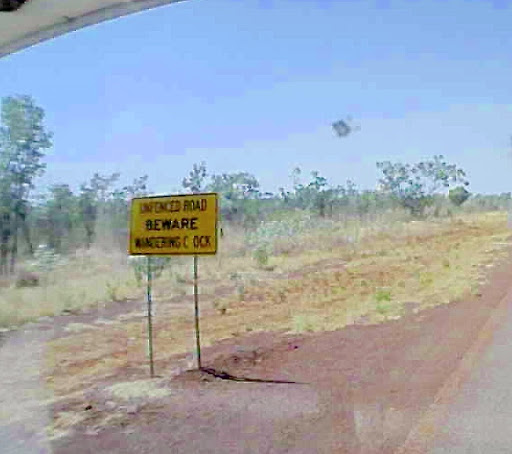
And a couple of reminders of just how big this country is:

Just endless vistas of dry Mitchell Grass from horizon to horizon.
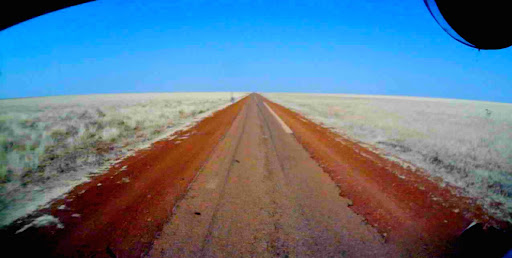
The front A/C worked pretty well during the morning session but struggled in the 36º heat this afternoon. Tomorrow I’ll check if the rear solenoid is the faulty item and if not, I’ll rig up a connection from the compressor so we can use both systems again.
325km today over the single lane, undulating Tablelands Highway south to the Barkly Highway and a fairly crummy but just adequate rest area about 150km east of Tennant Creek.
11 Sept, anniversary of 9/11.
This morning I tested the rear a/c solenoid and it appears to be OK so I wired it in to the compressor circuit and both front and rear a/c systems now seem to be working, but I am keenly anticipating disappointment. The solenoid should actually be connected to the rear fan switch so it only comes on when the rear fans are on but that will have to wait until I can find the right wire.
The remaining 150km 0f the Barkly Highway were fairly forgettable but we were quite surprised by Tennant Creek. It’s a mostly Aboriginal town but unlike many similar towns, the locals were more friendly and approachable and many of them are working in supermarkets or similar.
Grog limitations are still annoying though, only low/mid strength beer before 3pm and no cask wine before 4pm, and nothing after 6pm. Anyway we got some beer and cider which will do us until we get to Alice.
We checked our emails and called Mark, all is well in Adelaide. We called Troy who is house sitting for us and arranged our homecoming on 20 Sept. We also had a message from Scott and Tash who are in Rome. They just went to St Peter’s Basilica and the Colosseum tomorrow and are loving their European vacation.
After refuelling and refooding at a very expensive (except for veggies surprisingly) IGA in Tennant Creek we drove down the very quiet Stuart Highway to a small track we found several years ago about 70km south of Tennant Creek, and are camping about 1k off the highway.
Very hot again today, 36º but the A/C is working fine, but I sense the temperature trend will now be downwards.
12 Sept
The drive today took us past the Devils Marbles, always a good place to stop and frolic amongst huge stone boulders.
It also took us through Barrow Creek, the centre of the sad Peter Falconio murder and Joanne Lees assault some years ago (2001 actually).
But has someone been reading my blog??
A couple of years ago I reported in these very pages that although Barrow Creek had a Telegraph Station as early as 1872 it didn’t have a mobile service in 2010. Well today, in 2014, I am able to report that Barrow Creek now has a new shiny phone tower and megawatts of solar power:
The 1872 Telegraph Station and its contemporary high tech wiring system:
The 2014 mobile phone tower and solar farm:
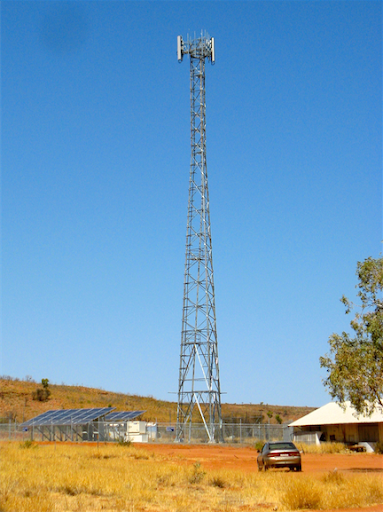
On the section of the Stuart Highway south of Barrow Creek, the speed limit has been de-restricted, in fact removed all together, it’s an “open speed zone”.
So this road could be one of the very few places in the world where you can legally travel at 500kph, (or more if you had the technology) and it’s not an autobahn or an autostrada or a freeway in Dubai, it’s just the main 2 lane connecting highway between north and south Australia. This section is around 40km, dead straight.
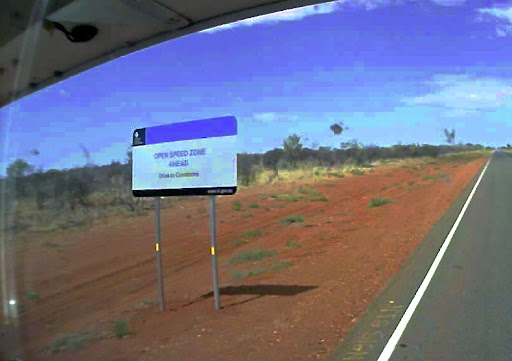

But as you accelerate though the 200kph point you are required to read this informative sign. We couldn’t even read it at 70kph.

Althoiugh, it does have several 30 or 40km long dead straight sections, it’s not all straight, and because of the speed potential, bends are supplied with copious arrows. The average is around 12 per bend, but this long slow bend has 33 double sided arrows to guide speeding motorists around the corner:
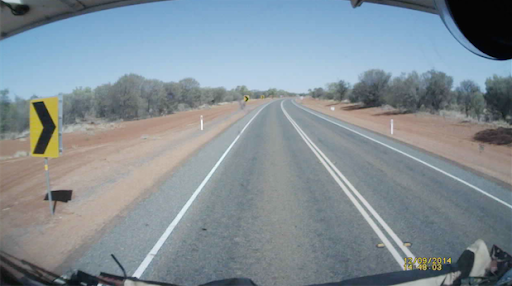
And continuing with the motoring theme, another notable thing of note that happened today was that our odometer passed the 700,000km point, of which we’ve done around 170,000 of them on our travels over the past 10 years. We’ve now lived in our Oka for nearly 3 years total out of the past 10, that’s over 1000 campsites on tracks which have criss-crossed the country.
Mind you the reading is a bit academic since I manually reset the readout to a random value when we had the odometer replaced in 2004 after we bought the Oka and it wasn’t working . The actual reading could be +/_100,000km from the current reading, and even that 100,000km estimate could be wrong too…
We are camped tonight at Prowse Gap rest area, a reasonably OK rest stop about 150km north of the Alice, and the temperature is dropping as the number of flies increases.
13 Sept
I made a pot of tea this morning as is usual, and I’m amazed how well I can consistently and accurately underestimate how much water is needed in the kettle. You’d think after all this time I would know and adjust my tap control process accordingly.
From our commendably average Prowse Gap campsite the drive into Alice was a lot more interesting than the previous 1000km. Some wild flowers were in bloom but not as many as previous years and the landscape was more hilly and tinged with green.
It was also noticeably cooler as befitting our no longer tropical latitude. We passed though the magic Tropic of Capricorn with barely a murmur.
After refooding, regassing, refueling and rewatering, we set off on the Ross Highway to Trephina Gorge for a day in a very nice area about 70km east of Alice in the East McDonnell Ranges..
The setting sun burnt up the rock face above Trephina Creek.
14 Sept
And the sunrise also lit up the bluff:
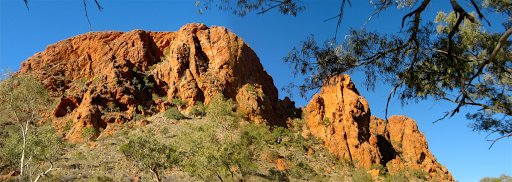
As proposed we did the 3km cliff-top walk today and it was quite a view.
We are now almost exactly in the geographic centre of the Australian Continent and the sky hasn’t been this blue for a long time. It does’t have the impurities and water vapour in it that you get in tropical skies, just pure, unadulterated UV rays.
The gorge from the cliff-top walk.
After our hot walk we had a cooling shower and decided to stay here for the rest of the day since it was so peaceful and pleasant.
As we were preparing tea, a dingo trotted along the creek bed to an old campfire area, picked up something, probably a chop bone, wandered back to a patch of grass and sat down to chomp it. She did this a couple of times and even circled us as we were eating our tea outside.
She obviously knows where food is to be found, but feeding them is not encouraged or permitted as they can become demanding and aggressive, even though she did remind us too much of Bella.
They may have the manner of a domestic dog but dingos are wild animals, descended from wolves, who have a well established position in the natural world as Australia’s dominant land predator. This status quo should not be disrupted since without them many introduced pests, particularly rabbits, would not be effectively controlled.
So it’s sad to see so many 1080 warning signs all over the country indicating the planned and systematic destruction of an Australian native species using strychnine, a particularly nasty poison.
Even worse is to see a tree adorned by the carcasses of dead dingos in trophy arrangement, which we’ve seen a few times. Imagine the outcry if you saw a tree full of the corpses of dead koalas?
The 5000km long dingo proof fence which runs from the Queensland coast to the Great Australian Bight in South Australia is a much more responsible approach at problem management in sheep country. Unfortunately 1080 poison is cheaper.
15 Sept
Leaving Trephina Gorge we went to see a nearby 300 year old Ghost Gum which is heritage listed. Ghost gums are common in the red centre, quite often on the side of red rocky cliffs.
This one is growing on a flat plain and is quite spectacular, they don’t normally grow this large.


On the way back, we called in to Corroborree Rock, an Aboriginal sacred site:

The surrounding hills are dotted with ghost gums as if they’d been planted.
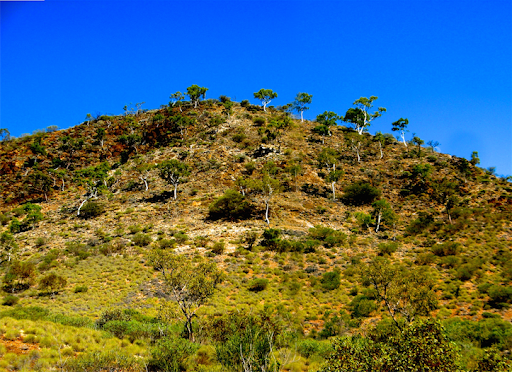
Then it was back into the Alice, if she’ll excuse the expression, for more supplies and fuel, after which we bade her farewell and set off south, but not too far, about 100km, to Rainbow Valley.
This is an ancient but spectacular set of rock formations which must be one of Australia’s best kept secrets. It’s protected by quite a tough 22km corrugated 4WD track in, but there are also some good walks to do and a campsite to boot, if only the flies weren’t so friendly.
Along the boardwalk we startled a large lizard soaking up the warm sun.
The track to Rainbow Valley passes though a large grove of Desert Oaks and a carpet of wild flowers, but not as colourful or prolific as previous wetter years.
16 Sept
Time now to start heading south seriously if we are to be home on Saturday. The SA border at Kulgera is the first step.
We stopped at Erldunda to check emails but there were none of note. Quite a bit of traffic here but most was turning west towards Uluru.
Passing the first and last pub in the NT at Kulgera and into SA, we met more quarantine signs than “Welcome to South Australia” signs, but at least we got a bit of warning on this one.

The traffic was almost non-existent for 80 odd km and the country appeared to be completely terra nullis, so much so that I contemplated emulating a certain Lt Cook and claiming this land a new country, called SOD OFF (South of Darwin On the Finke Floodplain), or maybe SOD ALL (South of Darwin All Lost and Lonely). For a brief moment I did consider Foetid Utopian Colonial Kingdom but I feared the spelling might prove too difficult for some citizens who might resort too easily to the abbreviated form.
We saw no caravans at all and only one motorhome this afternoon. Did they know something and were staying up north in the warm?
We passed 2 empty rest areas whereas normally at 3pm they’d be chockers with caravans vying for the best of the worst locations.
After 320km today we have stopped at the Agnes River rest area where there was one camper trailer and a big bus towing a small 4WD, and camped near the nonexistent river amongst the maximum number of flies. Actually all rivers and creeks in northern Australia are real rivers, they are just upside down, dusty dry on the surface but deep down they are still moist, which is from where the river red gums extract their water through the dry seasons.
17 Sept
411km today, basically down the very lonely Stuart Highway through Coober Pedy and into the arid treeless plains of mid South Australia.
Coober Pedy was the same flat dusty terrain covered by neat mountains of white spoil from the opal diggings.
We topped up our water tank from their very professional 20c per 30 litre slot meter public water pump (which is much better than their previous hose hanging on a wire fence model) and then carried on since we’ve seen dusty outback towns before.
Leaving Coober Pedy, not a single “Thank You for visiting Coober Pedy” sign to be seen, every sign was facing the other way.
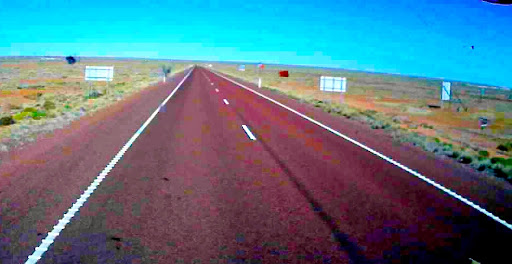
We camped last night at the “Major” Ingomar rest area, although quite why it’s so defined is a mystery. It has no toilets so the desperate have littered the rear of the site with paper products, it’s very exposed on the top of a bluff and isn’t very scenic anyway. No matter we (I) were knackered after 411km so it was fine for us, and we were the only occupants.
18 Sept
Up with the larks or what ever to carry on down the Stuart Highway first to Glendambo (Population: People – 3, Sheep – 22,500, Flies – 2,000,000) for lunch and to check our emails, and then on to Lake Hart.
This is a very pretty salt lake where there’s a 4WD a track we discovered several years ago from the new to the old highways and where camping is quite secluded.

The so called poached egg flower (Myriocephalus stuartii) which abound and all face the sun at the same time. They are paper daisies with everlasting (relatively) papery flowers.
We wandered down to the lake, and in the process crossed the Ghan/Indian Pacific rail line which skirts the lake edge. The lights were red and no trains came, so we walked along the track to tempt fate but fate wasn’t paying attention, fortunately.
There were emu and kangaroo prints in the salty edge of the lake.
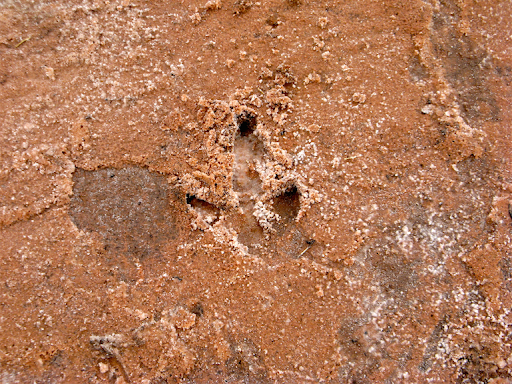
A stick and a moth frozen in ice and snow? No, captured in salt.
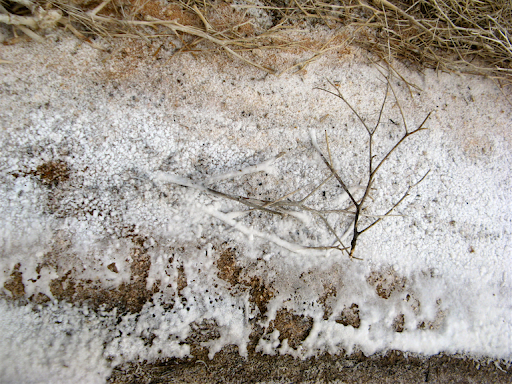

With a few clouds around, the sunset was quite spectacular. Yes, I know they are only bloody photons, but they are very colourful photons, nonetheless.
19 Sept
Our last day on the road, we should be home tomorrow morning.
2 freight trains came past early this morning, from different directions. I wonder how that happens? There must be a nearby passing loop or railway roadhouse they can stop at.
Unlike yesterday, today is a blazing blue sky day with a burning sun. Even a rusty exhaust system has a summery glow to it.
And the lake was glistening in the morning sun.

20 Sept
Camped last night in a small reserve at Clements Gap near Crystal Brook. It’s our normal secluded campsite, in a 10 sq km reserve of bushland in a huge arable landscape.
We arrived home knackered just after mid-day and the sun was shining from a clear blue sky and the temperature was around 22º. Good for Adelaide at this time of year but a lot less than we had been experiencing.
We wandered around in a bit of a daze, the garden looked pretty good really (it always does under a clear sunny sky) and not too many weeds.
We did a bit of unloading, a lot of washing and gradually things became more familiar.
Then we were back to normality once again after another good trip. 2 months, 9,000km and a major desert crossing.
Broome across to Darwin
14 Aug
Broome, a day of contrasts.
Up early for the final boring 100km to Broome (after all the excitement of a desert crossing), where we attacked the Coles supermarket, the first we’d seen since Halls Creek and even that wasn’t all that flash.
We were also slowly getting used to being on our own again after 2 weeks in the company of 2 other Okas and 4 other travelling companions. You get used to seeing people in front or behind (or even to the side) knocking over trees and bouncing over spinifex clumps or chatting on the CB, and then suddenly it’s all quiet again but with a lot of busy highway traffic. We now have to used turn signals again and check in the rear view mirror for high speed road trains.
But before we reached Broome, knowing that finding accommodation can be a real pain there, we checked into the Broome’s Gateway, an all non-powered, camping and caravan emporium about 20 mins east of Broome, for a couple of days. $27 a night off which we got a return visitor discount of 10% since we stayed here for 2 days a couple of years ago, they had us on their computer. It’s a nice bush location 20km from Broome with wide sandy tracks and sites, uncrowded and with plenty of water and space.
And then it happened, problème du jour #1. When we pulled up at the Gateway, I switched off the engine and there was an explosion of noise and water from under the kitchen sink in the rear. I’d fitted a relay which inhibits the water pumps while driving, so if a leak happens the pumps wouldn’t come on and empty the tanks all over the road without us knowing. Today they emptied the tanks all over the floor of the Oka instead. I quickly sussed out that the problem was a valve, which I’d fitted to connect the drinking water supply to the domestic supply in an emergency, had failed, allowing both pumps to spill their guts out, so to speak.
A simple enough problem to solve, if you have a replacement valve or a couple of plugs to block up the pipes, but I had no spare valve easily to hand without dismantling something else and only one plug. I couldn’t locate anything else that would fit, I tried clamping bolts in the pipes, bending the pipes over, jamming in a stick whittled by Janet and even an AA battery (rechargeable). None of them stopped the water flow so I disabled both pumps and made the Mitre 10 store in Broome our first call, to buy up their entire stocks of plumbing components. A few minutes later and it was all fixed.
Our Oka parked in the middle of Broome:
Only then could we attack the Coles supermarket. Coles was well stocked and not as expensive as it could have been, given the remote location. We held off buying meat and some other purchases to give us another fuel discount voucher for tomorrow. Fuel at $1.75/l was much cheaper than any other local town (mostly $1.98/l).
There was another aspect to shopping in Coles that I never thought I’d see outside of movies and comedy shows, a young lady with her skirt actually caught up in her knickers, a bit like this actually:
Janet was all for telling her but I said why ruin a perfect day? Anyway she’d probably blurt out “my husband noticed… etc. etc.”.
Then we found problème du jour #2. While we were driving around Broome, I thought the steering felt a but lumpy, and when I checked, the front RHS tyre looked very soft, which was confirmed by an actual measurement of 25PSI. This was the tyre that went flat in the GSD which we plugged with 2 plugs on the track and it saw out the remainder of the trip OK.
So we pumped it up and wallowed down to Broome Port where we replaced the wheel on firm bitumen in the shade of a huge oil tank. The replacement tyre is much better, it runs smoother and is better balanced as well. The soft tyre was leaking around the plugs after several days of rugged desert travel so I inserted a 3rd plug and it seems to be holding, but it will only be an emergency spare, pending getting it professionally fixed. I was glad it had gone down here, not on the highway where it might have burst ahead of a very large road train…
After the rigours of replacing a wheel in the heat, we sauntered around the port area and up the still corrugated sandy track to Gantheaume Point for the usual sunset photos, then back to the campsite for steak and salad.
At the port we spied this strange vehicle. What could it be?
It turned out to be a Limo Trike which you can hire an $295 an hour for specialised cruises around Broome:
Me having a cool drink (not champagne) at Gantheaume Point:
While waiting for the sun to set:
And it did:
Now just the leaking water tank to repair when we get somewhere soft and warm and not windy. It’s been blowing an easterly gale for several days now, mostly during the day, which makes working outside very frustrating, even if it is warm.
And just to complete the trilogy of water problems, I had to fix problème du jour #3. Our drinking water pump has slowed to a crawl so I bought and replaced the 0.5 micron filter element from the smallest Bunnings store I’ve ever seen, only about twice the size of my shed but surprisingly well stocked.
15 Aug
Today’s forecast temperature is 29, but it’s only about 14 at the moment and very chilly when you’re dressed for 29 and it’s very windy too.
Lunch spot at Roebuck Bay, Broome at high tide:
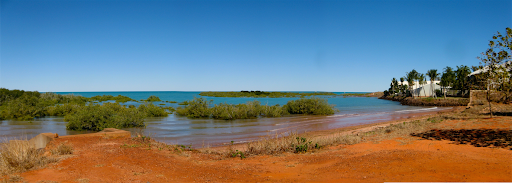
While having lunch at Roebuck Bay we spotted a few other interesting things.
A statue of a lady with concrete boobs, commemorating the contribution of women to the development of the pearling industry in the Broome area. Presumably the pearl shaped boobs contributed to this contribution in some way:
And I was not alone in photographing these contributions;
And a sea eagle which had caught a bat which carelessly left it’s mangrove roost in the middle of the day:
A rusty push lawnmower on the beach:
Boabs overlooking the bay:
The Pioneer Cemetery at Broome’s Town Beach:
It looks very much like a western Boot Hill:
It also commemorates the 70 people killed in Japanese bombing raids on flying boats laying at anchor in Roebuck Bay in March 1942. We were fortunate to visit the wrecks of the Catalinas on a hovercraft trip at very low tide in 2007. They were full of civilians being evacuated from Indonesia.
Roebuck Bay at high tide:
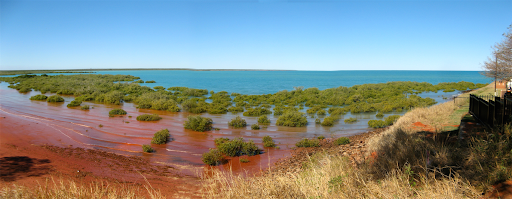
Our Oka parked under a bean tree in Broome:
Later in the afternoon we dawdled up to Cable Beach for the sunset, as one does.
How to take a Cable Beach photo, iPad style:
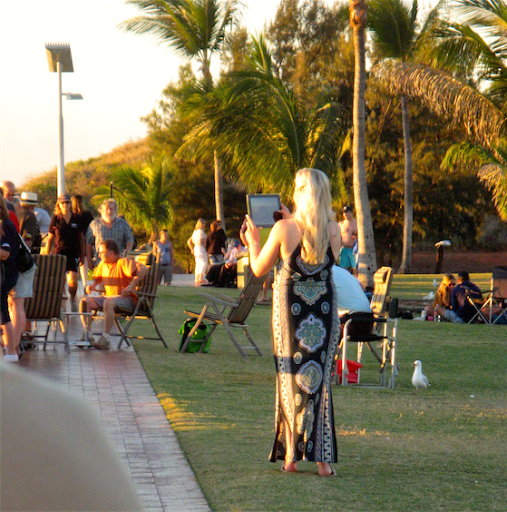
Waiting for sunset on Cable Beach:
And here it is, more bloody photons and wasted pixels, but for some reason everybody does it:
16 Aug
Leaving Broome today and heading east, but first we went back into Broome for the Saturday Markets in the grounds of old Courthouse.
Janet bought a “thing” for her hair:
And I found a few other things of interest:
Yeah right.
If only I could find someone to apply this to me:
No idea what these are:
The new way to protect your mouth from UV rays:
Lots of hangy things made of shells:
On the way from Broome towards Fitzroy Crossing we passed this Oka, they waved but we didn’t recognise it or them.
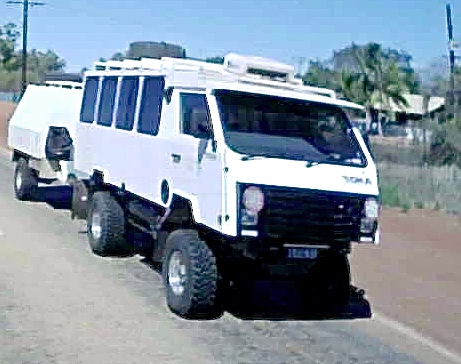
Crossing the Fitzroy river:
Boabs at Wellare Bridge:
More huge boabs along the roadside;
Smoke started appearing on the horizon:
And soon we were approaching the Gates of Hell:
Video of us passing through the Gates of Hell:
//player.vimeo.com/video/103583390
The Gates of Hell from David and Janet on Vimeo.
17 Aug
4 weeks since we set out, it seems a lot longer considering what we have done over those 4 weeks.
Last night we camped in a gravel scrape alongside the road, only 3km from a rest area, although we didn’t know that of course. Anyway our spot was nice and secluded and we had it all to ourselves, not jostling amongst caravans.
We had only done 70km today when we passed “The Lake”, a large rectangular man-made dam for watering stock. But it’s also a camping area with access allowed by the station owners and quite nice so we went in for a look and stayed all day to do some maintenance.
I took our leaking water tank out and eventually discovered a small hole in the PVC bladder. I’ll need some PVC cement from the next hardware store to fix it.
We needed some washing done so we used the lake water…
and so did the local wildlife:
18 Aug
From our quite nice Lake campsite we trundled down to Fitzroy Crossing for some water and hardware supplies.
The Fitzroy River was wide and still, unlike the wet season.
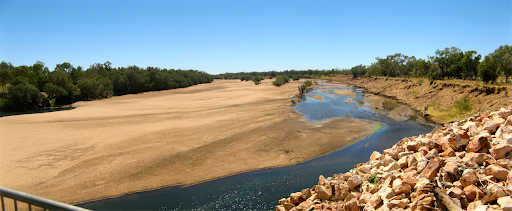
The FC Visitor Centre was far from friendly. We asked if we could use their tap to top up our water tanks and the young lady said, “normally yes, but someone has stolen our tap top so we can’t turn it on.”
So being an engineer, I went outside and turned it on with my pliers and topped up our tank. However, that was apparently all wrong, Ms boss lady came out and said “you shouldn’t be doing that, you might damage the tap and then I’d have to get a new one which will cost me money”.
Too late by then though, we already had our 50 l, but I had asked first. It wasn’t a very welcoming start to our FC visit, which then lasted only as long as a trip to the very helpful hardware store for a vinyl patch for a small hole in our flexible water tank.
Later we stopped for lunch at the very place where we had met up with Dave and Pauline only a few weeks ago at the start of our desert crossing, and met this very friendly lizard that had made his home in an old tyre:
The breakaways from the Ngumpan Rest Area were quite nice:

We motored on intending to get to our previous Laura River camp spot but we passed the Mary River rest area and popped in for a look. It was quite nice and not too many people there so we decided to stay.
Well we should have motored further on, by nightfall there were over 50 vans etc milling around and it became a bit of a caravan slum. We will never learn apparently.
19 Aug. our 42nd wedding anniversary
Now it’s 9 am and I’ve glued and clamped the patch on to the water tank, 2 actually, a larger one over the top of a smaller one, (well it wouldn’t make much sense to do it the other way around) and the place is almost empty again.
The clamps will remain on the tank until I can get around to refitting it.
And so we bade farewell to the Mary River campsite, which actually looked quite nice after most caravans had left, and drove down to Halls Creek for a few bits of fruit shopping, then headed north towards Kununurra.
We stopped to look at some very pleasant groves of boabs growing along a creek line:
The scenery became quite pleasant with rolling hills and creeks with water in them, not unlike the Marble Bar region.
From a distance, this piece of tatty wire mesh on the old crossing looks just like a crocodile. Are we becoming paranoid?
Then we started seeing Fruit Fly Restriction signs for the Kununurra area, “No Stone or Citrus Fruit from April to December”. We hadn’t seen this restriction before so we are having mandarins and custard for dessert tonight.
A slithery moment
We were camped alongside the Warmun Creek this afternoon, sitting outside having a quiet beer when a long black snake, at least 20m long, but actually around 1.5m, slid along the edge of the grass towards us.
I involuntarily lifted my feet off the ground and said “Hey Janet”. She saw it at the same time and lifted her feet too. The snake must have sensed something, movement or vibration, and turned a sharp left into a clump of grass about 1 meter from us and shot off at alarming speed, leaving us to slowly regain our normal heart rates.
This a recreation of the exact same spot so we can avoid it next time:
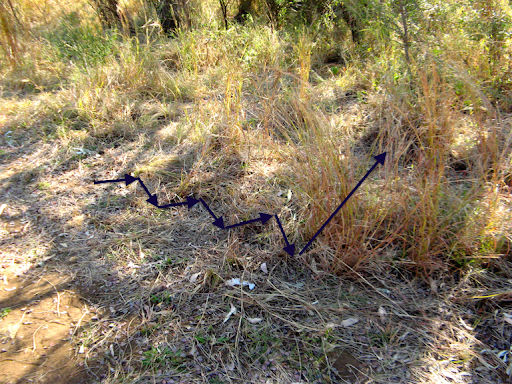
Not sure what type it was, maybe a brown snake which lives in this part of the country and can be black in colour. Either way, not an animal to be trifled with until you know what type it is and even then, not to be trifled with.
When normal heart rates had been recovered, I erected a tall NextG antenna and got a reasonable service, enough to know what Clive Palmer was up to today, but the modem claimed to have a flat battery and kept turning off. It refused to charge and turned out to have an overheating battery so a few minutes in the fridge and all was OK again.
20 Aug. 42 years, one day and still going strong
Continued up the road towards Kununurra past many road work restrictions and single lane bridges. Started seeing pandanus palms along creek lines which now have water in them. And it’s getting decidedly hotter. However, my decision to blow out the stuff from my radiator seems to be paying off, the temperature doesn’t rise above 90º now with A/C on and with a hot engine, but Darwin conditions will test that theory.
On the way we passed this very old car/caravan combination. It doesn’t seem the right sort of vehicle for these remote, hot outback roads, with 100’s km between service centres. Maybe cars (or their drivers) were built tough in the and 30’s and 40’s:
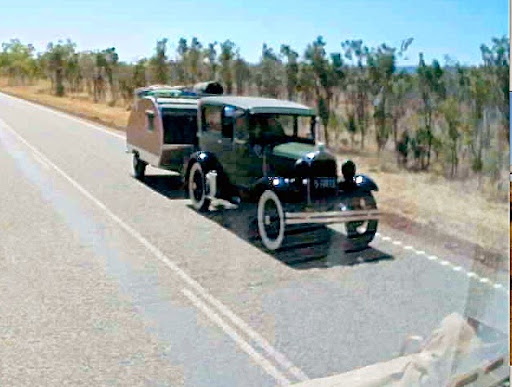
Tonight we are camped at an exclusive and free gravel scrape a few km west of Kununurra for a couple of days and I feel a rant coming on.
I don’t like Kuna much anymore, it seems a big hot dry dusty place now, not like the small green tropical oasis it used to be. We went to the Zebra Rock Gallery to feed the cat fish and be spat at by archer fish, but even that wasn’t as much fun as before.
There is still plenty of water about and big empty grassy areas but there are so many restrictions it makes one feel trapped.
We went to check out the Pump Station Restaurant where we had a good $20 night out with Charles and Fred a few years ago but that has gone downhill while the prices have gone up. $38-45 for a main course? Plus side dishes? That’s almost as much as a Big4 caravan park. I’m not being cheap but Value For Money is and always will be the criteria.
The ANZAC Hill memorial overlooking the Kununurra Valley is a sad place, just a few white concrete blocks scattered about the dusty ground, a boab tree and a bunch of flowers. No monuments or plaques of any kind. Maybe they’ve been taken away for restoration but there was nothing to suggest that, and the gates are still locked at night, to prevent what exactly?
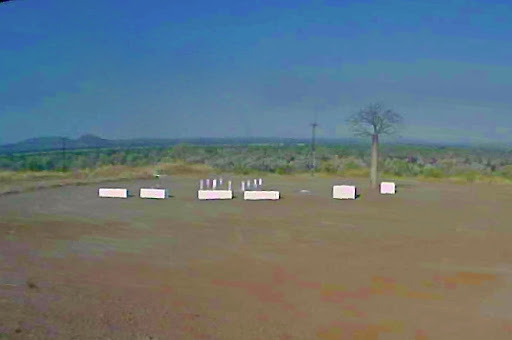
We did do some washing and refilled the water tank in Kuna but fuel is $1.92/l so that’s not cheap either. Overall Broome was much nicer and much more economic.
We’ve done 1128km since leaving Broome with about 450km to go to Katherine and reasonable fuel cost again so I’ll need to put in a splash of fuel to get us there. Not many fuel stops between here and there (Timber Creek, Victoria River).
I’ve taken a happy pill now so everything will feel better soon.
Tomorrow morning while it’s still cool I have to refit the glued up water tanks and test it and on Friday we have booked a half day cruise on Lake Argyle with lunch thrown in ($95 each seemed reasonable although the concession was only about $5 less), before heading east into the NT.
21 Aug
The water tank is now refitted, not without some difficulty and a few swear words, but it’s now 3/4 full and it seems to be holding water.
Janet had another wildlife scare when she nearly trod on a land crab. They are supposed to hibernate in deep mud until the rains come but this one got woken up too early.
We bought a few items in Coles, got our fuel 4c off and came up to the Swim/Ski Beach for lunch.
The last estuarine crocodile sighting in Lake Kununurra was 14 July, like only a month ago, so the Swim/Ski Beach may have to be renamed.
A dragon tree near the Kununurra Swim Beach. The only other dragon trees we’ve seen were in the middle of a desert:

After lunch we were sitting around, in between float planes taking off and wondering what to do when we had an idea. Instead of our exclusive and free gravel scrape campsite tonight, why not drive up to Lake Argyle and stay in the caravan park there where we will be nice and early for our cruise in the morning. And so we did.
It’s a 1 hour, 70km drive to the “resort” and it was very crowded when we got there but they had plenty of space as long as you weren’t waiting in line behind 6 camper trailers all wanting to camp together, which of course we were.
However our simple needs took precedence and for $30 (not too unreasonable) we soon got an unpowered site in what turned out to be one of the most spectacular caravan parks we’ve been to.
The views over Lake Argyle were stunning, as was the “water to the rim” swimming pool. Apparently voted the most stunning pool in Australia, and I want one, especially with that view.
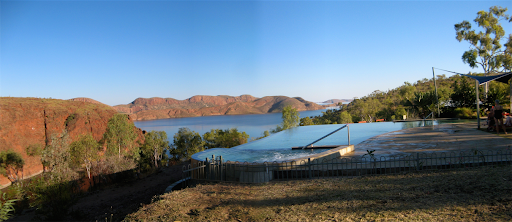
A helicopter was on standby in case anyone needed a sunset cruise over the lake. No doubt he’ll be up with the larks at 6 am tomorrow morning as well.
Sunset over Lake Argyle
22 Aug
Early morning cruise today, preceded by a very interesting 1 hour video on the construction of the Ord River dam and its infrastructure, but not before bacon, eggs and tomato for breakfast, with bacon(!!).
The cruise was much, much more interesting than we had anticipated with a very well informed and almost continuous presentation from a young Kiwi, Josh from just north of Wellington with a PhD in Australian Raptors.
The lake looks big on the map but it’s not until you get down to it that you realise just how big it actually is, 70km long, 35km wide and up to 44 meters deep (today), there are parts where you can’t see the hills on the far horizon and the views are, well, stunning.
Here’s our cruise in pictures:
This is our cruise liner, 50 seater, all aluminium catamaran, with powerful twin Cummins diesels, although there were only around 25 persons on board for our cruise today. It was named the Kimberley Durack, (the grandson of Patsy Durack who first acquired the land in the 1870’s) who saw the benefits of damming the Ord but sadly didn’t live to see his vision completed.
The dam wall took 3 dry seasons to construct and is made of compressed clay with a rock protective covering. It’s very small considering the vast volume of water it’s holding back (18 to 70 times as big as Sydney Harbour, depending on the wet season variations). Currently the lake area is more than 1,000 sq km (up to 2,000 sq km in the wet season and can be 9m higher than the current water level). It was anticipated to fill in 7 to 8 years but actually only took 3 years.
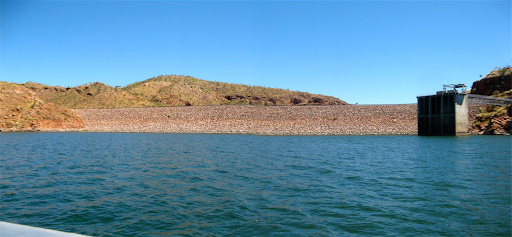
Cruising at 40 kph:
The size of the lake becomes apparent as we rounded the local islands and headed out across the lake:
We passed pelicans and black cormorants:
At least Janet wasn’t sick, the lake was flat today but the waves can reach 3m during wet season storms:
The boat cabin was spacious and light with no windows to block our view (fully air-conditioned and it was pleasantly cool).
I took a turn driving the boat while we were doing a pedestrian 17kph between islands (but our moving map display is bigger than Captain Jack’s):
The end of the lake is 50km away and over the horizon:
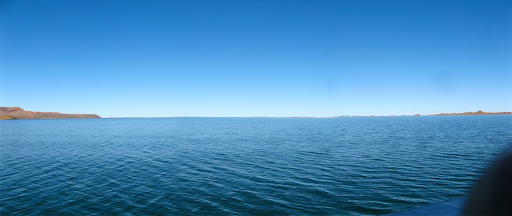
We stopped off at a large island where local wallaroos had been relocated to by environmentalists Harry Butler and Malcolm Douglas in the early 1970’s as the lake filled.
A nearby “Kimberley Rose”, a pretty small tree with sticky red flowers on it:
Later we stopped on a beach on an island for lunch and an optional swim:
You’d think we were cruising a major ocean.
Lunch was BBQ’d Silver Cobbler, a large tasty catfish variety from the lake (which is highly sought after in Perth fish markets) plus chicken, ham and salad, with beer or wine:

On the way back (and after the swim, lest anyone be scared witless), we visited a section of the lake shore where freshwater crocodiles nest. There were an estimated 25,000 freshies in the lake at the last survey, but fortunately no salties (as yet discovered):
The flat-topped Argyle diamond mine is visible 35km away to the west:
Downstream from the dam is a hydro power system which supplies Kununurra, Wyndham and the Argyle Diamond mine with environmentally friendly power: This is also the Ord river which is dammed again in Kununurra (by the diversion dam) as a water supply. Overall, the original flows of the Ord have been maintained, despite having created the largest freshwater lake in Australia.
This Ord river tributary which is now a spillway exit for the lake still flows with its original flows although it’s fairly low in the dry season:
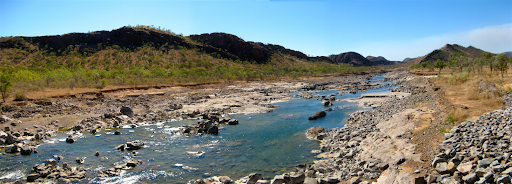
Crossing the Ord River I saw a beautiful Jabiru Stork (now boringly called a Black Necked Stork):
This cruise was one of the best experiences we’ve had in a long time. We been to Lake Argyle several times before but never had a cruise before. Janet takes all the credit for the idea but I take the credit for turning it into an anniversary pressie.
Warning political rant follows:
Overall, the statistics of Lake Argyle are mind boggling, or at least mine was boggled. And ultimately made me sad but mad.
1000 sq km surface area, evaporation rate of 200,000 l per day, and enough water annually to supply all of Australia’s water requirements many times over. The peak flow rate in the 2011 wet season was the second highest in the world after the Amazon, measured in millions of gigalitres per second. During March 2011, they received 1400mm of rain in 3 weeks in the catchment area.
But the area under irrigation is actually relatively small, 12,000 hectares and most of this is now used for growing Indian Sandalwood for a Chinese company. Why? That was never the original intention. So after all this work and expense, very little is actually used for growing crops for Australians and worst of all, almost all the Ord’s water still flows into the Indian Ocean at Wyndham.
Same old sad story, lots of resources but in the wrong place. Plenty of water here but it’s needed down south. Plenty of solar energy in the centre but the consumers are all down south. The WA minister who dreamt up a canal from the Kimberley to Perth got the idea right but the technology lags behind. Shipping solar energy (electricity or something made with it) to major cities down south should be quite possible.
It’s not rocket science, it just takes governmental guts and determination, not piddling around with parental leave schemes which generates no benefit. A 500km water pipeline from Perth to Kalgoorlie was installed in the 1880’s. The engineer was hounded into suicide by opposition doubters but the pipeline was built and is still in use today. The Snowy Mountain scheme of the 1950’s reversed river flows to irrigate the inland of NSW, so all things are possible. Currently we can ship thousands of tonnes of live beef, iron ore and natural gas around the world but can’t ship a few litres of water a few km south. Instead we spend $billions on desalination plants.
This one touristy cruise has opened my eyes to the total stupidity and lack of vision of our governments, of all persuasions. I would happily give back my $550 (if I ever got it) from the carbon tax if I could see something worthwhile being implemented, but sadly I’m reminded of dead horses and how it’s a waste of time to flog them.
The words “Government” and “long term vision” can no longer be used in the same sentence.
End of rant.
This afternoon we left Lake Argyle and headed into the NT, only a few km east but 1 1/2 hours ahead in time, to camp in the Keep River National Park at the Gurranldalgn campground.
But first we called in at the Ranger Station at Cockatoo Lagoon for a quick look. It seems to have a bit more water in this year and looks as pretty as ever:

23 Aug
At first light (plus a bit) we did a very nice 2km walk over the Gurranldalgn hills, one we’ve done twice before but it’s very picturesque.
It was quite nice to find some cool shade even at 8am:
And a shady hole in the rock. I bet no one has ever had their photo taken here before:
A large “leaf” from an Acacia Dunnii. Actually we discovered that acacia leaves are not true leaves at all but flattened stems painted green, which accounts for the fact that veins in acacia leaves run parallel to the stem, not across like most leaves.
The view from the escarpment in the early morning sun was spectacular and looks like a mini Bungle Bungles:

A bank of silver leafed acacias agains the rock wall:
A very pretty but unidentified mauvey-pink bush with a magnificent backdrop:
After our walk we left the Keep River National Park, at least as far and the entrance track where I stopped to grease the clutch release bearing which had started squealing. Much better now.
We then drove down the monotonous mostly burnt out highway towards Timber Creek. About 20km west of TC is the Gregory Tree, a large Boab alongside the Victoria River (a major crocodile river) blazed by Gregory and his mates in 1856. He named Timber Creek since it was the best location for acquiring timber for boat building.
We stopped to look at the 200m wide Victoria River and all looked pleasant and calm until I blew up some pictures from the opposite bank.
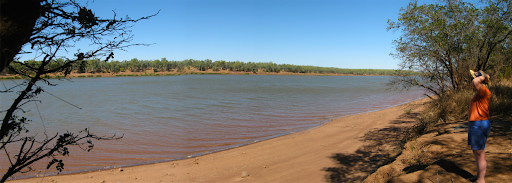
These “logs” on the far bank have changed places in the space of about 1/2 hour.
A blown up section but you can see the head on the right and the curled around tail on the left.
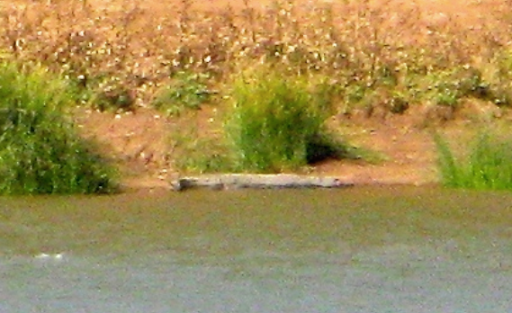
We are camped overlooking this spot on the nearside bank but at least 100m from the water’s edge and 10m up on an embankment. We had a close encounter with a croc a few years ago on the Mary River east of Darwin and have no wish to repeat the experience.
We did have a visit from a couple of kangaroos though.
Tomorrow we strike out for Katherine.
24 Aug
Before striking out for Katherine, we thought we should actually have another look at the Gregory Tree which was the purpose of our side trip anyway.
Augustus Gregory was tasked in 1855/6 to determine if claims of good cattle grazing country in the north of Northern Australia were true (which he did and they were)
The nearby township of Timber Creek was established and named by Gregory as a source of good timber, surprisingly enough.
He established a base camp on the Victoria River and his artist, Thomas Baines, inscribed this then much smaller boab tree with details of the expedition’s progress, including the date July 2nd 1856.
These twin boabs were also referred to in Baines writings as a direction pointer to the camp. Janet wee’d behind them, or was about to when some other tourists appeared and curtailed the process.
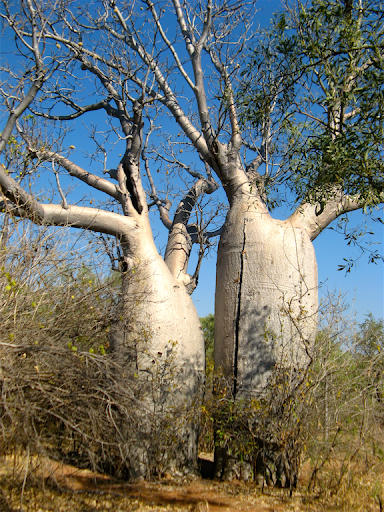
On the way back we spied this northern rosella in a boab tree with some boab nuts (all parts of which are edible):
Does this bull’s face (on a neighbouring station) remind you of something out of Star Wars?
Leaving such imponderables behind us we continued east to where the Victoria River become narrower and shallower, to where an early causeway had been built.
Not a bad lunch spot?


Radjah Shelducks were foraging in the shallows:
The old causeway is looking in a sad state after 100 years of wet season’s raging torrents:
We reached Manbulloo Station Stay, just west of Katherine at 4pm after 1600km and 7 days from Broome, for a couple of days maintenance and shopping before heading north to Darwin.
5600km completed so far on this trek, about 3500km to go.
25 Aug
Had a lazy morning so far, managed to access the internet for what to do in Darwin that we haven’t already done.
A day trip to the Tiwi Islands seemed like a good idea but when I searched for info all I got were confusing and misleading stuff about Aboriginal Tours (the only kind you can get and need a permit to visit anyway), and nowhere to book an economical tour ($250 by ferry or $450 by air, each) either. So I looked at Trip Advisor and all the comments were negative, waste of a day, no culture (no dancing, no art sites, no scenery etc), all time spent in one arts place, childish paintings, expensive arts, money, money, money etc and basically waste of time and money.
So that’s off the agenda, in favour of a $30 per 24 hours hop on-hop off double decker bus tour. It got tons of good reviews, even though we’ve done most of the places before, not having to drive, park, walk about in the heat seems a more and more attractive option.
In the afternoon we went shopping in Katherine for food, fuel and gas, all successfully, plus Janet bought some shorts in Rockmans as she always does. It was stinking hot but the counter girl in Rockmans was wearing jeans, a long jumper and a woolly scarf and still complained of feeling cold. Must have had hypothermia or ebola or something else exotic.
Follow the other sections of our 2014 trek here:
Power Door Locks update
Introduction
During our 9 month trek around north and eastern Australia in 2005, the Oka performed very well but one of the frustrations we encountered was having to walk around the vehicle locking and unlocking the doors by key every time we left it or returned to it.
Since I had to remove the drivers door lock for maintenance (the door wouldn’t stay closed sometimes due to build up of dirt in the mechanism (see here for how I fixed this problem) I vowed then to investigate central locking, preferably by a remote control.
The remote function is a fairly easy add-on to complete the process, but the mechanics and electrics have to be working first.
I used a 4 Door Power Door Lock System from Jaycar (Part LR8812, $39.95), plus some microswitches for each door and then added a Remote Control System from Oatley Electronics (about$50.00). Total cost was about $150, plus a few days work.
The hard bit is getting the solenoids mounted and operating effectively, the slightly easier part is electrical wiring.
How has it Worked in Practice?
This system has now been in operation for more than 8 years and we’ve had remarkably few problems:
1) Occasionally the rear door locks itself. This is due to vibration which can shake the operating plate down into the lock position, but only on the rear door, the design of which is inverted from the front doors due to space constraints. It can easily be fixed by locking and unlocking the doors.
2) If the auxiliary battery (or which ever battery is powering the system) is isolated (or flat), the doors locks can’t work. This might seem pretty obvious but it can be annoying while I’m doing maintenance work, when I forget, and can’t unlock the doors. The normal door key still however.
3) Such is the reliability of the system, we frequently don’t even remove the keys from the ignition when we leave the vehicle (it’s difficult to see in anyway due to its height plus we have an immobiliser). We just lock the doors electrically, which works fine, but does place more reliance on the external hidden switch/remote control working when needed. It’s advisable to secrete a normal door key on the outside of the Oka, somewhere vibration-proof, for peace of mind.
How It Works
Oka door handles work by a pusher, bolted to the rear of the key lock barrel, which pushes a striker plate on the door mechanism to release the catch.
If the doors are then locked, by turning the key 180º, the pusher misses the striker plate and does nothing, the doors will not open.
Oka door locks aren’t like ordinary cars and can’t be automated by direct access to the door handle pusher:
1 -It would need the pusher lever rotated 180º to change from locked to unlocked or back, which is difficult to implement, and
2 -The barrel won’t turn anyway unless the key is inserted, which defeats the object
of the exercise.
In this implementation, a movable extension is added to the lock striker plate, and is rotated in and out of the path of the pusher by a solenoid. While in the key locked position, the door handle pusher opens the door by pushing the plate, when it is moved into place by the solenoid, ie. “unlocking” the door. The pusher misses the plate when it is moved away from the pusher, ie. “locking” the door.
This modification does not affect normal internal door opening, closing or locking mechanisms, which will all still work. It can only affect whether the external door handle can be used to open the doors or not, and then only in the key locked position. The unlocked position by key will still work as normal (but obviously prevents the solenoids from taking effect). Thus this mod cannot prevent entry to the Oka, even if something fails. (You can, however, still lock yourself out if you try hard, see Potential Problems and Fixes).
The worst case failure mode is that the modification could prevent one or more doors from being locked from the outside. This could happen if one of the moving plates jammed in the unlock position (unlikely) or a solenoid or the electrical supply/fuse failed (more likely).
In this event, the moving plate would have to be rotated out of the way manually and the key used as normal for door locking until the problem is resolved.
(See Potential Problems and Fixes).
|
|
|
Figure 1a and 1b, Moving Plate System (Unlocked Position) |
|
|
|
Figure 2a and 2b, Moving Plate System (Locked) |
Note the moving plates were enlarged a bit after these photos was taken to increase the area the pusher had to push against. It was too close to the edge in this design.
How it is Implemented
The 4 door power door lock kit from Jaycar comprises a master and 3 slave solenoids, fixings and wiring harness. They also have a 2 door version.
A solenoid is fitted to the catch mechanism of each door driving a moving plate as outlined above. The master solenoid is fitted in the drivers door.
Microswitches are mounted inside the doors, operated by tabs on the internal door handle lever, to lock and/or unlock the door solenoids from inside the vehicle. These are optional but greatly increase the flexibility of the system.
For this implementation to work, doors must remain in the locked position, by key, at all times. Only then can door lock solenoids enable or disable entry, by moving the plate in or out of the path of the door handle pusher.
If the doors are unlocked manually by key, the solenoids can have no effect either way but the doors will open normally (eg. in case of solenoid failure or stuck plates).
If the doors are subsequently locked manually by key, entry status will be determined by the position of the solenoids.
|
|
|
Figure 3 Solenoid and Plate Mounting – Top View |
|
|
|
Figure 4a and 4b, Solenoid and Plate Mounting – End View and Installed View |
(Rear Door, Locked Position, note the pusher rod will miss the plate when the handle is pressed)
Solenoid Operation
Solenoids have to be triggered via one or more of the following methods:
1 – a remote control, or
2 – an external, hidden, 2 way momentary action toggle switch or magnetic window switch, to lock or unlock all doors (simple, but a small security risk), or
3 – microswitch(es) mounted on the internal door frame/rails operated by tabs fitted to the internal door handle levers to unlock all doors when opened from inside (and relock all doors if 2 microswitches per door are used).
This is so you can go outside at night, for example, without the door locking behind you, and then relock all doors on re-entry. The remote is not necessary for this.
4 – Internal security switch to lock or unlock all doors from within the vehicle.
Any or all of these options can be implemented concurrently since all switches are wired in parallel. My recommendation for best functionality and reliability is to use all four methods.
Note: the remote and additional switch functions can be added after the system is otherwise operational.
Operating Summary
In this implementation, Power Door Solenoids can only enable opening or non-opening (locking) of doors while the handles remain in the locked position, by key.
Solenoids cannot lock the doors if the locks are unlocked by key.
Normal external and internal door opening and locking mechanisms are not affected by this mod, although the internal locking position could be deemed redundant (see below).
An internal, momentary action, security switch could be added (or by using the remote) to activate the solenoids whilst inside (at night for example) to enable, or prevent, access from outside. This does not affect operation of internal door mechanical door locks, but has essentially the same result, and is a bit easier than crawling around to each door in turn.
A remote control entry system can be used to energise the solenoids, subject to the above requirements and is the best solution.
Information on the Jaycar Power Door Lock system can be seen at http://www.jaycar.com.au/images_uploaded/powrlock.pdf
The Jaycar Door Lock Kit, part no. LR8812 at $39.95 for 4 door kit (cache)
Also Jaycar LR8839 remote keyfob entry system for $69.95 see http://www.jaycar.com.au/productView.asp?ID=LR8839&CATID=&keywords=
8839&SPECIAL=&form=KEYWORD&ProdCode
Only=&Keyword1=&Keyword2=&pageNumber=&priceMin=&priceMax=&SUBCATID= (cache)
Oatley have usable remote systems a bit cheaper and more flexible (but not as elegant and have to be assembled) see Oatley Electronics
The K203 is a 2 or 4 channel kit, with 2 channels used for Lock and Unlock functions.
The additional channels could be used for turning lights or other electrical equipment on remotely.
Dick Smith has a 4 door solenoid set for $50 and appears to be similar to the Jaycar kit. They are also available on-line via eBay.
Door Lock Mechanics
Construction of the door lock system needs a degree of precision fiddling to get the solenoids into the best position to operate the moving plate, while providing clearance from the door mechanism, door frame and window slide.
Four components must be manufactured for each door (see attached photos and diagrams, microswitch plates not shown). Note that the left and right hand doors will need mirror image brackets and plates.
1 – Right angle bracket, bolted on to the striker plate. This is attached by 2 screws to prevent movement and forms the basis for mounting a sliding striker plate extension. See picture below of solenoid assembled on rear door catch.
2 – Striker plate extension mounted on the above bracket by 1 screw and well greased lock nut, such that it can rotate. It has a 3mm hole to accommodate the actuating rod from the solenoid. (You’ll probably need to remake a few of these before getting it right, since the shape depends a lot on the relative location of the door handle pusher, which can vary from door to door and with wear on the lock barrel).
3 – “Z” rail__ for mounting the solenoid, bolted to the catch mechanism frame, using
one existing and one new hole, both countersunk.
4 – Plate for mounting microswitches in the doors.
|
|
|
Figure 5 Mechanical Components for Door Locks |
I used 2mm steel for the brackets and moving plates since they have to bear all the force of the door handle pusher against the catch mechanism.
For the “Z” rail and microswitch plates I used 1mm steel (actually part of the Oka
outside skin, left over from access panels cutouts).
The microswitch plates were made from aluminium.
Countersunk screws are essential for fixing the major components, to minimise protrusions which could foul the door frame or the rotating door handle pusher, particularly the 2 shown below, which can prevent the catch fixings lining up with the door frame:
|
|
|
Figure 6 Solenoid in Position showing Screw Heads to be Ground Smooth |
Nyloc nuts are advisable to avoid loosening due to vibration (remembering this mechanism will difficult to get to for maintenance). Loctite could be used as well.
The manufactured components were painted with RustGuard for protection and to hide manufacturing deficiencies.
|
|
|
Figure 7 Moving plate showing ruler for scaling. |
Note, this is an enlarged moving plate from those shown in Figs 1 and 2. Subsequently, I had to grind off the corners (left and right as shown in red) so it didn’t foul the door frame and window slide in operation. The area where the pusher hits can just be seen (in blue) and shows why I had to enlarge it, it was very close to the edge.
Installation
Removing the Door Lock Mechanism
To remove the door mechanism:
1) Ensure the window is wound up, remove internal door handle and window winder,
2) Remove the interior door trim (the little plastic Christmas tree fixings can be difficult to remove. A sharp pair of pliers or scissors can be used to lever them out),
3) Loosen and move the window slide nearest the door catch out of the way (see below),
4) To move the window slide, remove the 2 fixings (6mm bolt to rail inside the door and 6mm screw at the bottom of the door),
5) Turn slide through 90º exposing its flat side before moving it (there is insufficient
space to manoeuvre it in its normal orientation),
6) Twist it up horizontal and rest it on the window ledge (see picture below, you will need to reposition it frequently to check clearances). Avoid damaging the window molding in the slide,
7) Undo the 2 screws holding the internal door handle mechanism in place,
8) Click up the external “U” shaped catch plate to the fully upright (door closed) position,
9) Undo the 4 Allen headed countersunk screws holding the door catch mechanism in place,
10) The door mechanism can now be manoeuvred out through the cut-out in the door.
11) To make it easier to work on the catch mechanism, remove the circlip holding the internal door operating lever on to door catch mechanism and remove the lever (replace the circlip to avoid losing it).
|
|
|
Figure 8a and 8b, Shows Window Slides relocated to enable catch mechanism to be removed |
The mechanism will probably be very dirty and covered with a thick layer of grease mixed with bulldust. It should be degreased before being worked on. (Note for reassembly: a foam surround to the catch mechanism would reduce ingress of dust).
While the door mechanism is out, the external door handle can be removed, although this is not necessary for this mod. Just check that the pusher lever is securely fixed to the lock barrel.
Also the window winders are worth checking at this time for operation of the friction pads, and tighten if necessary (see photos). Both our front windows slowly slid down on rough roads then rattled and let dust in. To improve the friction, I glued a section of rubber strip on to the pads before tightening.
|
|
|
Figure 9 Window Winder Friction Pads |
Rear Door Differences
The rear side doors are slightly different to the front cab doors.
They have no window slides but are narrower than the front doors and have restricted depth, so the “Z” rail bracket will need to be further modified to fit, but the principle remains the same.
Also the moving plate system for the cab doors didn’t fit in the space available above the catch in the rear door, so a variation is required.
Instead of the plate moving down to enable opening, on the rear door it’s hinged lower down so that it moves up to open. This only requires that the wiring to this solenoid be reversed, which works just fine since they are bidirectional anyway.
All door plates could be made this way if desired, but I had already done the cab doors before I discovered the rear door space problem.
|
|
|
Figure 10 Rear Door Solenoid Mounting |
(Note, the end hole is not required, it was left over from an earlier version which wouldn’t fit in the rear door.)
Fitting and Adjusting the Solenoids
Bolting the solenoids to their “Z” rails is easy enough if you can locate some 3mm x 35mm long screws and Nyloc nuts (Coventry Fasteners stock them).
Alternatively use 3mm or 1/8th inch tapped rod with lock nuts each end. Don’t use the self tapping screws provided in the Jaycar kit, they could work loose through vibration or from the forces exerted by the solenoids.
The solenoids must point roughly in the direction of the hole in the moving plates, but it’s not that critical. The 3mm holes in the moving plates are located so that they don’t foul the rotating barrel lock pusher, and give the necessary movement of the plates when the solenoids operate (approx. 18mm stroke).
What is critical however, is that the solenoids and moving plates fit in the space available and don’t foul the window slide or internal door lever when operating. Since each door catch pusher is slightly different in position and operating angle due to wear and assembly, even if only by a few mm, this can effect the operation of the moving plate.
Developing the solenoids fixings and moving plates for the door catch will therefore probably need several fit and adjust phases to ensure nothing fouls the door frame or window slide. I had to remake the moving plates a few times and grind edges off to ensure everything fitted.
Each door catch needs to be test fitted (including bolting the window slide back into place) and checked operationally before final installation.
I assembled and adjusted the microswitch plate as part of this test fitting, but then found it necessary to remove it so I could manoeuvre the catch mechanism and internal door lever through the opening in the door panel. I then refitted the microswitch plate when the mechanics were all OK.
Adjusting the length of the actuating rods can be time consuming and best done on the bench before the mechanism is fitted to the door. In fact the whole door system can be wired together and tested on the bench using the wiring harness provided before any fitting is started. All it requires is a 12 volt supply to the red and black wires, and the ends of the brown, black and white wires stripped so they can be touched together to simulate door switch operation.
Using the rods provided in the Jaycar kit, don’t bend them yet, put them through the hole in the sliding plate, slide the brass tapped block provided on to the rod and secure with a 4mm bolt through the eye in the end of the solenoid arm.
This temporary arrangement allows the length of the rod to be adjusted on the bench before making the rod a permanent fixture. To do that, mark the exact hole centre of the solenoid arm on the rod and remove it so that a 90º bend (parallel to the plane of the moving plate to allow for movement of the striker plate) can be made in the rod at that point. Then reinsert the rod in the moving plate and poke the bent end through the eye of the solenoid arm. Hold in place with glue, tape, spire nut or other removable fixing.
The pressed steel flat nuts provided with the Jaycar kit can be used to hold the rods in place if opened out a bit and pushed on the rod. Tap a piece of rod through them first to open them out, slide them on to the rod when in position and then pinch the little tabs flat, if necessary, with long nose pliers. They hold quite tight but a dob of glue would make quite sure, but still be removable.
When in place, the rod should be tight, but loose, if you see what I mean. Tight enough so there is minimal slop as the solenoid operates, but loose enough to allow for movement of the striker plate without placing stress on the solenoid arm when the door handle is pressed. Some experimental rod bending might be needed to achieve this outcome.
As insurance against a solenoid or electrical failure causing a door to be stuck in the unlocked position (ie. can still be opened but not locked), a hole could be drilled in the side of the door frame above where the catch mechanism is bolted and in line with the moving plate.
This would enable a screwdriver or similar to be inserted to lever a stuck plate into the lock position and the key then used to unlock and relock the door. The hole should be plugged by a blanking grommet. If it is a hard fault, the system should be switched off (remove the fuse) and the key used until the fault is fixed.
Door Lock Electrics
The wiring harness included with the Jaycar kit is comprehensive and long.
However, it assumes that the control box is installed first and the cables are then run out to each of the door solenoids though the body and into the doors. In practice, I found this to be back to front and impractical.
Since every car and installation will be different, it’s more logical to decide on the location of the control box, fit the door units, then connect the wiring loom to the solenoids, feeding the loom through the internal space of the door, across the hinge area and working back to the control box in the body of the vehicle.
You can’t do that with the harness as provided, so the wires to the doors will need to be cut near the control box connector and rejoined after feeding them from the doors and getting the lengths right.
The location for the control box needs to be near a source of +12 volts (fused, but unswitched so it’s on all the time), ground (0 volts), and any internal switches. Under the dashboard to the right of the steering wheel is convenient in our Oka, and an internal lock/unlock security switch can be located nearby. If a remote control is ultimately added, its control box can be located here too.
BTW, note that the Jaycar documentation refers to +12 volts and -12 volts. They really mean 0 volts or ground in place of -12 volts.
|
|
|
Figure 11 Control Box mounted behind Dashboard |
For provision of an external switch, 3 wires (brown/white/black) can be added from the internal switch and taken to the centre console area for access to the outside of the Oka in your chosen location. The lengths of the wires are not critical and can be very long if desired so it could be fitted almost anywhere.
Feeding the wires across the bottom of the Oka doors is fairly easy, but must be low enough to avoid the window when wound down. A new 12mm hole (with a grommet) will be needed on the hinge side of the door and a corresponding hole (with a grommet) on the fixed door frame, in a position which enables the wires to make their way into the cab. This should be a few cms higher or lower than on the door to allow the cable to twist and flex as the door is opened. Where the wires run outside the body of the Oka, cover them with some plastic sleeving or spiral wrap to protect them.
The drivers door cable has 5 wires in it for the master solenoid, the other door cables comprise only 2 wires for the slave solenoids. An additional 3 wires are required to doors fitted with microswitches (except the drivers door, see below). Extra wires and the microswitches, if fitted, are not part of the Jaycar kit.
When laying out wiring, allow for additional white (Lock), brown (Unlock) and black wires to the passenger and rear door(s) for microswitch installations (see diagram below). No additional wires are required for the drivers door since the white, brown and black leads go to the master solenoid anyway. The drivers door microswitches can be connected into these existing wires.
All like coloured wires will ultimately be connected together but it’s not necessary to bring them all to the control box first. Wires from the rear door can be connected to the passenger door wires in the passengers dashboard area and one set taken across to the control box.
|
|
|
Figure 12a and 12b, Electrical Block Diagram and Microswitch Wiring Diagrams |
Microswitch Implementation
I fitted each door with 2 microswitches, one to unlock the system when any internal door handle is used to open a door, and one to sense that any door has been mechanically locked from inside and relock all doors. This second switch is only really necessary on the rear door, where you might want to relock all doors after reentry at night, but while I was working on them anyway, it was easy enough to put 2 in on all doors rather than have a change of mind later.
A tab was bolted to the door operating lever in the opening of the inside door panel. This pushes the actuators on the 2 microswitches as the door lever moves. See pics below (of the rear door system).
|
|
|
Figure 13 Microswitch Panel in Normal Position |
The microswitches were mounted on the inside of an aluminium panel bolted to the door panel. On the rear door, the door handle fixing bolts can be used to hold it.
The location of the switches requires a bit of trial and error to ensure they operate at the right time but don’t get too stressed by the movement of the tab. I made the tab from a piece of plastic angle to give some flexibility when striking the microswitch actuators. Also I angled the microswitches so that there was more of a wiping action. Both of these techniques will reduce the stress on the switches. The positioning of the switch plate needs to ensure that the tab won’t slip past the switch actuators at the normal extremes of movement and bending of the door operating lever. That’s why the switches are on the inside of the panel.
|
|
||
|
Figure 14 Microswitch Panel in Unlock/Open Position, which is spring loaded
Electrically, all like switches are connected in parallel. Even if one switch is in the lock position, operating any of the other unlock switches still triggers the system, since the control box senses the negative edge of a switch signal, not it’s on or off status. |
Remote Control
A remote control can be added to the system quite easily. I used a kit from Oatley Electronics (K203 plus K203E) receiver and two Tx7 key fob transmitters.
The receiver kit provides 4 channels (by adding the K203E components), 2 of which I used for Lock and Unlock. The other 2 will be used for Internal Lights on/off, and External Lights on/off. Alternatively, these 2 extra channels could be used for any other remote electrical switching (eg TV/Radio or Car Alarm).
The key fob has 4 buttons plus a sliding cover to protect them from accidental use. It also has a small telescopic antenna which Oatley claim increases its range to 100m plus, but is not needed for short range.
I could have used the add-on remote kit from Jaycar (LR8839) which comes already assembled and is easier to incorporate. However it only provides lock and unlock functions and I wanted a bit more flexibility.
The Oatley key fob transmitter is easy to assemble, just put the battery in and screw together.
|
|
|
Figure 16 Key Fob Transmitters and Receiver Board |
The receiver is an electronics kit which requires assembly of a printed circuit board and is a bit more complex. I left out several components which are unnecessary for triggering the door lock system but which would be required for powering other electrical equipments. I can provide additional info on the receiver assembly if needed.
The circuit board will require mounting inside the vehicle near to the control box. It requires +12v and ground, and 2 outputs (I used “A” for Lock and “B” for Unlock) must be connected to the White and Brown control box wires. I mounted it under the centre dashboard area. The 6 inch antenna wire can just dangle somewhere.
I fitted a small piezo buzzer to the “Lock” output so it beeps when the “A” button is pressed to indicate the doors are being locked. I figured unlocking the doors was pretty self-evident anyway, but it could be connected to the unlock function too via a couple of diodes. The receiver could also be used for flashing the lights or beeping the horn to indicate that it has done its job. This would require the additional components (relays mostly) that I left out of the receiver construction.
|
|
|
Figure 17 Receiver Circuit Board. |
The area under the buzzer is where the additional 2 channel components will fit when I get around to them.
Note 1: The key fob transmitter and receiver can be encoded to provide security so they will not respond to other systems encoded differently. You can choose from thousands of codes, implemented via wire links. Sketchy details are in the kit or on the Oatley website. The system will also operate perfectly well unencoded but with less security. See encoding areas in the photos below. The receiver and both key fobs must be encoded exactly the same and this will require a fine soldering iron, thin wire and a steady hand.
|
|
|
Figure 18a and 18b, Encoding Connection Areas on receiver and Transmitter circuits. |
Both must be wired the same.
Note 2: the K203 receiver kit is based on a small PIC microprocessor which decodes the transmitter signals and provides a timed momentary or latched output signals. It therefore has the potential to be reprogrammed to perform other functions (such as a longer timer or flasher or personal alarm) using a PIC programmer.
Potential Problems and Fixes
Shock and Vibration
Since the solenoids are not energised all the time, only when moving the plate up or down, I was concerned initially that vibration from the moving vehicle could rattle the moving plates down from their locked to unlocked position. However, that is the fail-safe position anyway, normally one wouldn’t travel with doors locked. When the moving plates are up in their locked position, the vehicle will generally not be moving so this problem won’t arise.
Contrary to this however, in practice, the action of the pusher on the moving plate initially caused the plate to work upwards to the lock position, after 30-40 presses due to the leaning action of the catch plate when pushed, and the proximity of the pusher to the edge of the moving plate. This is not a fatal flaw, just a bit annoying.
This was fixed by remaking the plates slightly larger so the pusher was further away from the edge of the plate, tightening the lock nut further and then putting on a separate nut locked up tight against the lock nut to keep it tight. Even Nyloc nuts can work loose it seems when used to lock a rotating screw.
With the rear door mechanism being reversed there is an outside chance of the moving plate working down to the locked position while on the move, but it is only the rear door, and the mechanical door mechanism will still work anyway.
Experimenting with tightening the bolts holding the moving plates suggests that they can be bolted up quite tight, if well greased, so they can rotate but not drop down, and the solenoids are still powerful enough to operate them.
Getting Locked Out
After fitting this mod, it’s still technically possible to lock yourself out of the Oka, but you’d need to plan ahead. You would have to lock the doors electrically, leave or put all the keys and remotes in the vehicle, get out and shut all the doors, This will lock you out, since the door locks are always keyed in their locked position for the system to work.
That’s why you need a hidden, external lock/unlock switch, which should be tested regularly so it will work if and when needed. This switch should be a marine grade, 2 way momentary action switch to survive the elements and can be wired in parallel with the microswitch connections, since it does the same job. It needs to be momentary action in both directions so it does not interfere with normal microswitch operation. Dick Smith P7658 and P7689 (very small) switches would work but both need protection, maybe mounted in a small plastic box. At a more professional level, Carling Technologies manufacture an array of marine switches, available from Amelec Australia in Perth, www.amelec.com.au.
Note 1: if the switch ever fails, just whip the white or brown connections off the back (one of them will unlock depending on how it’s wired) and short to the black wire or to the chassis, or just short the terminals of the switch with a piece of metal. (You can’t use a key since you locked them inside).
The switch should be mounted in a hidden but protected area so that access is possible to the rear wiring. An alternative (or addition) would be a miniature reed switch mounted inside the windscreen or window. This can be activated through the glass from outside by a small magnet carried on the key ring or stored outside the Oka somewhere, and would avoid the need for an external switch. Keep the magnet away from wallets or purses however, or it might zap your credit cards.
Note 2: it has always been possible to lock yourself out of an Oka even without this system installed. You would have to lock all the doors with the key while they are open, put all the keys inside the vehicle and then shut all the doors. So all this implementation does is to give you an alternative method of locking yourself out!
Stuck Plates
In the event of a stuck plate or solenoid/electrical failure, the door trim would have to be removed so that the offending plate can be manually shifted to the unlock position. The system should also be disabled (removing the fuse is the easiest way) until the problem can be rectified. Normal operation using the key is then possible.
If felt necessary, a hole could be drilled in end of the door frame so that a screwdriver could be inserted to shift a stuck plate. The door trim would then not have to be removed.
Other photos or info on the implementation are available to anyone who wants to do
this mod. Contact me at dandjribbans at internode dot on dot net
Adelaide to Halls Creek
20th July 2014
We are finally on our way. It took a lot of last minute stress and commotion but we finally got our stuff packed and mostly operational and left home just before lunch.
After a lot of upgrades to the mechanics of the Oka over the past 3 months, to meet the challenges of a desert crossing, we left with some trepidation. Had I done it right? Were there bolts left loose waiting for their moment to cause maximum trouble?
In the past 2 months, I’d:
Replaced the front differential for an automatic locking type,
Removed the rear axle (which took a lot longer to do than to say) to replace the rear differential with a Limited Slip Diff.
We’d got bogged last year partly though not having any locking differentials and we weren’t going to allow that to happen again, were we?
I also:
Replaced the rear gate hinge pins which were wearing thin,
Replaced the rear brake cylinders, pads and seals,
Replaced the font axle oil seals which are always leaking,
Replaced the transfer case rear oil seal which was also leaking.
Replaced our laptop computer with a new Macbook Air which of course needed setting up as a navigational system for our moving map system,
Had most of the A/C system pipework repaired or replaced as it stopped working last year,
Had a replacement windscreen fitted (under warranty) after last year’s version cracked massively though no fault of ours and ended up looking like crazy paving.
The reason I did all this upgrade work is that we are meeting up with some friends in Halls Creek in WA to attempt a crossing of the Great Sandy Desert from Fitzroy Crossing to 80 Mile Beach via old mining tracks, where they exit, or making or own way over the intervening sections where they don’t, not something you’d want to attempt alone.
Our prime objective is to reach Dragon Tree Soak in the centre of the desert (and return safely to earth of course).
We did a lot of pre-planning and have track info and map plots of people who had done this before but that won’t make the challenges any less, well, challenging.
So yesterday we reached Port Wakefield before our late lunch, all of 80km up the track. By late afternoon we’d reached Mambray Creek, 40km south of Port Augusta, a “No Camping” rest area we have camped in several times before.
21 July
Not surprisingly, we slept for about 10 hours, but a hot breakfast and even hotter shower rejuvenated us for the next leg of our journey, a shopping trip into Port Augusta.
After buying up 190 L of Woolies best diesel, we carried on up the track towards Alice Springs without realising that the rear gate with the spare wheel on it wasn’t properly closed and locked. My fault for not checking adequately and a few km up the track, flashing lights from a following vehicle alerted me to the problem, the rear gate had opened and was swinging wildly about with 100kg of wheel and other items attached to it.
We stopped ASAP as you would, and fortunately nothing was damaged except my pride and the safety strap I’d put on to prevent the gate from opening too far. That had snapped but presumably absorbed some of the kinetic energy of the swinging gate.
Relieved and mollified, we were soon on our way again. We also discovered minor leaks from the rear fuel tank and the main water tank, both of which will have to be fixed once their contents have dropped. Not serious, just annoying.
After the freezing last few days in Adelaide, the warm sun which appeared in a clear blue sky this afternoon was positively burning hot and we had to use the sun visors and opened the vents. Not quite A/C weather yet but a welcome change.
We stopped at Glendambo Roadhouse to post a birthday card to Diane for her forthcoming birthday which is promised to arrive by the one after. We should have posted it in Port Augusta.
After a long 450km drive today we are camped in the centre of the Woomera Restricted Area, just south of the 30º 30’ parallel.
We made contact with Dave and Pauline on the radio, who are at Cape Keraudren on the mid coast of WA, heading up to Broome. We haven’t made contact with Deano and Kaye yet who were in the Katherine area when last we heard from them.
22 July
Very clear still night with full on starscapes, I wish I had set up my camera on its tripod, and learned where the manual exposure controls were, other than the “Auto” mode.
Added items to our TWSF (Things We Still Forgot) list: my soldering iron, without which I can’t fix the LED lights which are continuing to fail on a regular basis, and a small frying pan for fried eggs. Ah well, the bright lights of Coober Pedy or Alice are still ahead. However I did buy a replacement for my iPad charger cable (which is also at home) in PA. It’s a nice dark pink Belkin one which nicely matches the gaudy pink protective iPad cover that someone other than me chose.
Today on our 480km travels we bypassed Coober Pedy except for a comfort stop, bypassed Cadney Park except to check the fan due to the engine overheating and then bypassed Marla completely without stopping (which is presumably what bypassing actually means).
We also came across another overturned 4WD with the roof crushed in. It had recently happened but emergency services were present and a tow truck came roaring down the road towards the site. Not for the first time have we seen 4WD’s overturned on this road, and sadly it’s the most common form of accident on outback roads and tracks, with speed and inattention being the main cause. A sad end to someone’s holiday with their belongings scattered over the roadside.
We are camped tonight at what I thought was the Chandler Rest Area but it’s not signed thus, so presumably that’s still before us. No matter, this is perfectly adequate for an overnight stop. I am manfully attempting to lighten the vehicle load for the forthcoming desert crossing by reducing our wine stocks as quickly as possible.
“Problèmes du jour”:
1) Overheating of the engine, not a serious problem right now but it will be when the temperatures rise and we have the A/C on.
The problem is that the viscous hub in the fan unit is not “viscousing” anymore and doesn’t lock the fan to its pulley when the engine gets hot. So I’m investigating ways of coupling the fan pulley to the viscous hub so they are permanently locked together. Ideas vary from brackets to tie the fixing their bolts together, wiring or roping the fan blades to the pulley or welding the whole bloody lot together.
Idea #1 is probably the best one, but in a 3 way radio hook up with Dave and Deano, Deano suggested looking at the spiral spring on the front (if it’s the original Oka type) and tightening it half a turn. A task for tomorrow when it’s light again and the fan is cool enough to actually touch. (Dave and Pauline were at Shelamar Station south of Broome and Deano and Kaye were in Kununurra).
2) The 9m whip antenna refused to function. But how can a piece of straight wire refuse to function? It was due to corrosion inside the connector on the end of the coax cable so I replaced both ends with new connectors (after a frustrating half hour searching for where I stored the crimping tool) and we are back on the air.
23 July
Rained gently on and off most of the night but quite warm, although no aardvarks were seen (just testing my spell checker).
Up early, bacon and eggs for breakfast, but without the bacon, and all before 7am. That’s what happens when you have no TV to watch and retire at 9pm.
The next 3 hours were taken up fitting straps to the viscous fan to lock the fan pulley to the fan hub. 20 minutes was used constructing the straps from some steel strips found on a discarded Westinghouse oven, and the remainder of the 3 hours was taken up reinstalling the fan and getting the 4 sodding fixing bolts to line up. Par for the course I think.
First I removed the fan unit and replaced 2 of the studs with long bolts so I had something to fix the straps on to on the pulley side:
Then I fashioned some straps from steel strips recovered from an abandoned Westinghouse oven (and while doing so, found a novel way of securing my vice to a solid surface):
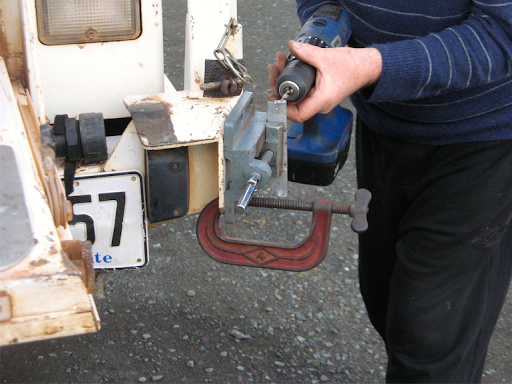
These were then attached between the fan pulley and the fan unit, locking them together, one on either side to maintain the balance. The straps are angled so the pulley “pulls” the fan around without any twisting, which, after all, isn’t that what a pull-ey is supposed to do?
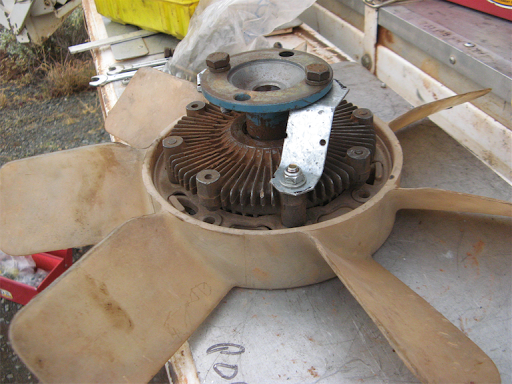
The fan unit installed, after 300km in operation:
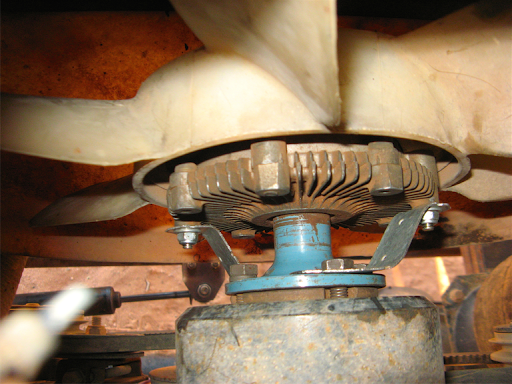
It works fairly well and drops the maximum temperature by 5º, but it can still be improved further with longer fan blades which actually fit the cowling properly and a fully working viscous fan hub to save power. It got quite hot this afternoon (27º) with a near cloudless sky, so we had the A/C on most of the day and the temperature remained within an acceptable range (ie, not boiling).
While I was working, a large road train passed by carrying another large road train:
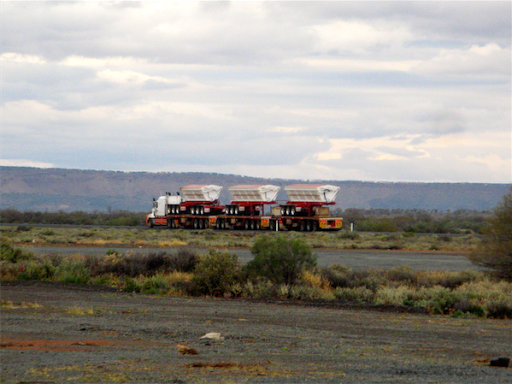
Had lunch at the SA/NT border and cruised through very scenic countryside to our campsite in the Owen Springs Reserve abut 60km south of Alice Springs where I had a couple of leaks to fix.
The Owen Springs Reserve was a former cattle station bought by the NT government in 2002 and opened as a free bush camping and 4WD tour destination close to the Alice. We are camped near the Redbank Waterhole which looks very pretty with ducks and mozzies and small flying creatures in abundance. And it is getting warmer.
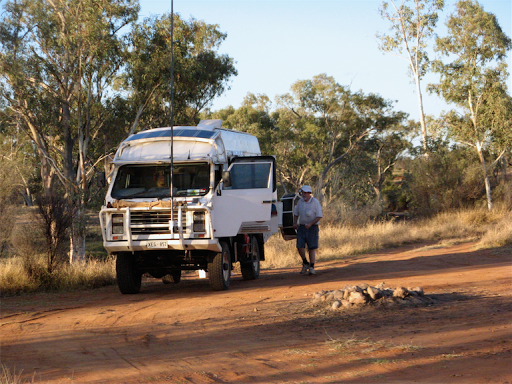
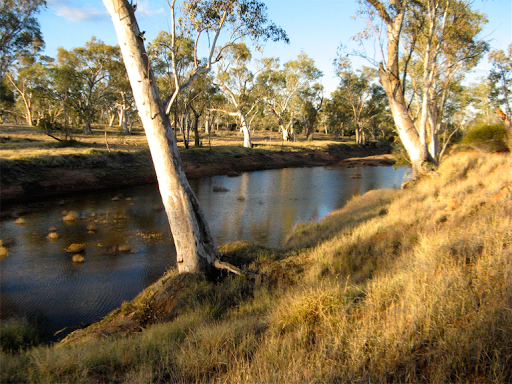
Shopping, “laundry-ing” and resupplying in the Alice tomorrow and then we set off NW up the 1100km Tanami Track to Halls Creek, a route we haven’t traversed since blowing out a tyre up there on our Disco in 2002.
But first I had to fix a couple of significant leaks, one on the rear fuel tank where the filler adaptor pulled away from the side of the tank:
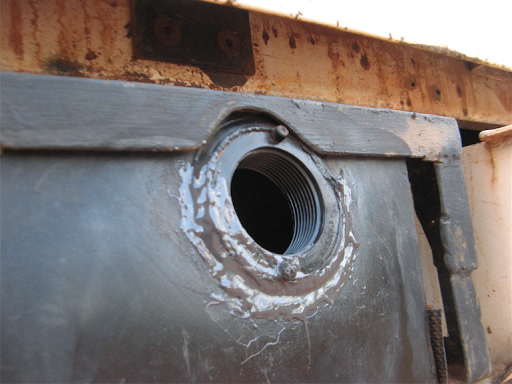
And another on a crack the side of our stainless steel main water tank:
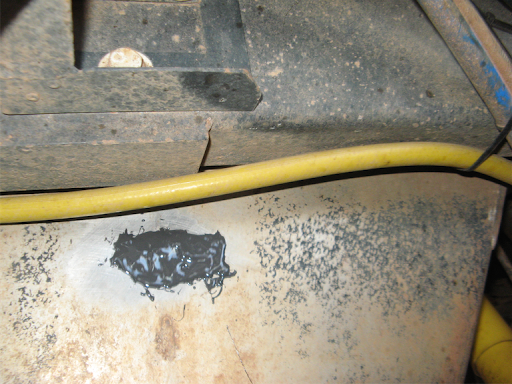
More epoxy liquid steel to be added tomorrow morning and we can try a test fill of both tanks (we do have several other tanks so all our œufs are never all in one panier).
1469km done since leaving home (without refuelling) with 65km to go to Alice and then 1100km to Halls Creek, a total of 2634km to get to the start of our desert crossing.
24 July
Happy Birthday Diane, hope you enjoy your day and any events planned to commemorate your milestone.
Owen Springs where we camped last night is quite a picturesque location and well worthy of further exploration when next we past this way.
The 65km into Alice Springs seemed a lot longer than it actually was but everything was very familiar to us when we got there since we’ve been there many times before (about 9).
We quickly located the Woolies supermarket which satisfied most of our culinary needs. The Home Hardware and K-Mart stores met all the others, except for the Town Library which met the comfort stop requirements since there are very few public loos in the Alice due to certain groups of people who appear unable to treat them well.
By mid afternoon, fuelled and watered up with 220l of diesel and 150l of water (both tanks fixings seem to holding), we headed north for the Tanami Track. This road north first takes us to the highest point on the Stuart Highway, around 732m. There is a plaque and monument to this point which tells you everything you need to know about the Stuart Highway except, that is, exactly how high the highest point actually is, we have to use our GPS to estimate it.
The first 100km or so of the Tanami Track are very scenic but particularly annoying since it has only a single strip of bitumen down the centre, and to pass another vehicle, both have to put 2 wheels on the gravel, showering each other with small rocks unless you both slow down. When one doesn’t, a chipped windscreen is the result and I hope we won’t have yet another cracked windscreen as a result. I guess we should be grateful because even this thin strip of bitumen will end soon and then we’ll be on to a gravel /sandy track for the remaining 1000km.
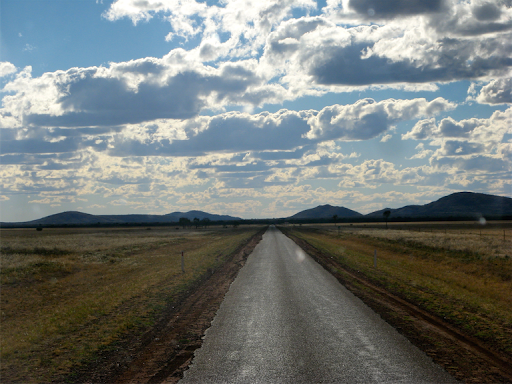
Threatening and dramatic scenery on the Tanami Track, but it was actually very warm and we had the air conditioning on all afternoon:
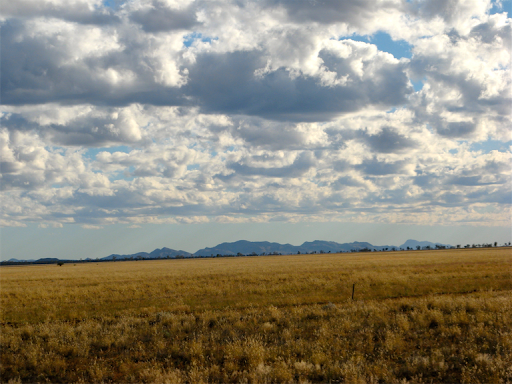
Somewhere along the track today, about 39km ago, we crossed the Tropic of Capricorn with no fanfare or signs and we are now camped at the Mt Chappie Rest Area about 120km NW of the Alice. Only done 220km today but we did spend 3 or 4 hours doing our “laundry-ing” and resupplying, one of the rare occasions when we actually achieved everything on our shopping list.
25 July
I was awoken very early when J went outside for a comfort stop and I thought I heard her softly calling me from the darkness, as if she was being attacked and abducted by some nefarious persons and somehow wanted my involvement in the process. I rushed out of bed but fortunately it must have been the breeze in the spinifex and the last thing she actually wanted was me assisting in her endeavours. You’d think she’d show a little gratitude?
Later when making breakfast this morning, I first got the all stuff out that I needed, but then I thought “is there a word for things you have to do before the first thing you do?” There ought to be, but this line of thinking could take some time.
It was and still is a hot blue sky day and I’m sitting at the table in the back of an Oka with a nice cup of tea (wine will follow) and the cooling fan blowing straight in my face.

The track however wasn’t quite up to the same standard. It started well enough with the single strip of bitumen, which became variously sandy corrugations or a full on 2 lane highway.
It never used to look like this (but sadly it’s only like this for only 20-30km, but why a small section of hifgway in the middle of an otherwise sandy track?):
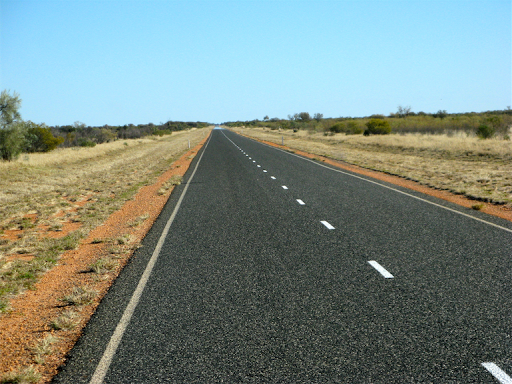
We did come across one strange sight blocking the track, what could it be?

The answer was a couple of huge mining truck trays being transported to the Granite Goldmine. Why they were blocking the whole track is a mystery, they were moving at about 0.2 kph, and yet one was overtaking the other.
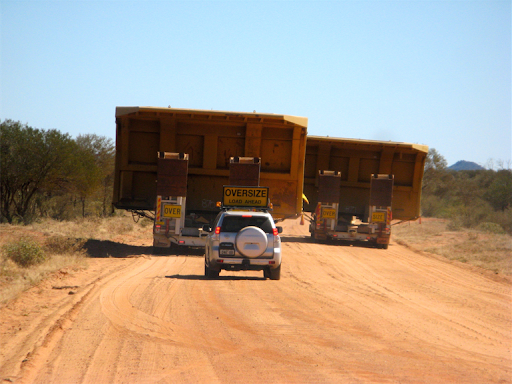
Eventually all of the above morphed into a very corrugated gravel track which made going very difficult, slow and/or noisy. Various nuts and bolts came loose but fortunately nothing serious.
And we did a few of touristy things along the way:
Ant mounds:

Some windmills:
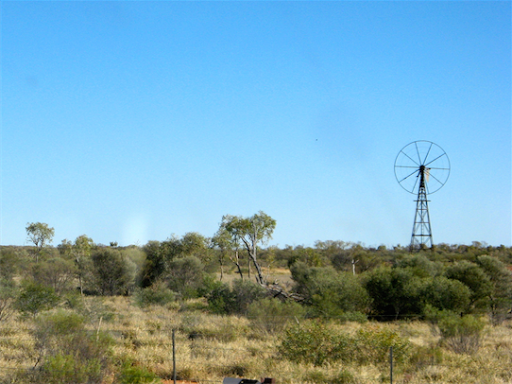
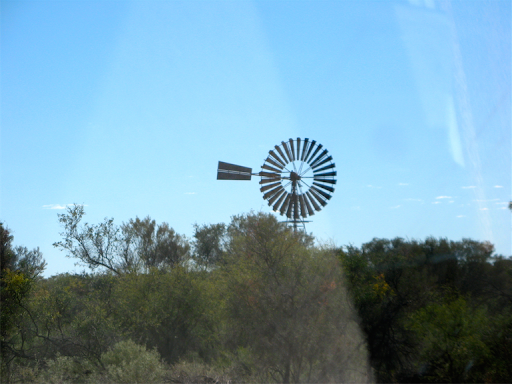
Some termite mounds:

A prickly bush:

A Cork Bark tree:

A small lizard:
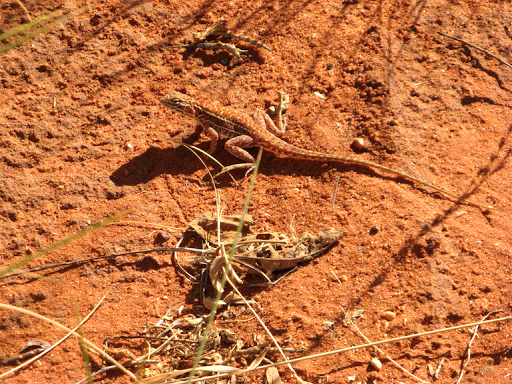
Holly Grevillea (this plant/small tree is very pretty but was to become our major floral hazard during the later desert crossing):
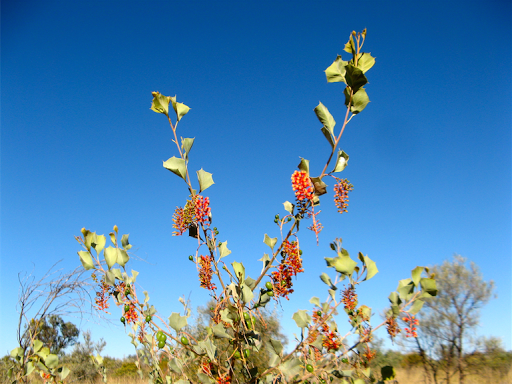
And a camel (they were also to become a pest later on):
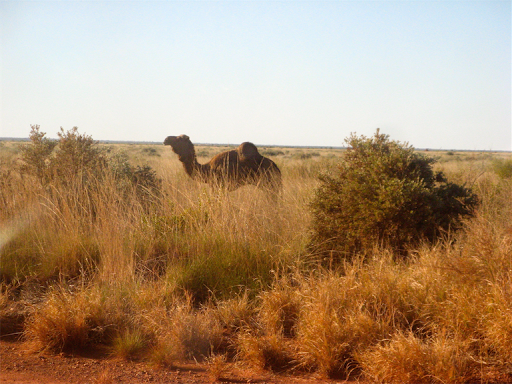
Despite the corrugated conditions we did manage 390 interesting km today with the A/C on, and we’re currently in almost the middle of the Tanami Track, 550 km to Halls Creek or 550km back to Alice Springs.
Our exotic dinner tonight is a quiche, but without the pastry, cooked in a camp oven and served with sweet and normal potatoes.
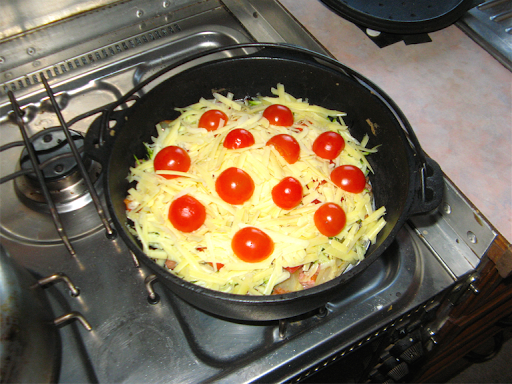
Janet got a bit hot slaving away in the kitchen so I used a tie wrap to tie back her hair.

A road train rolled past the setting sun:

And we had a nice Tanami Desert sunset:

26 July
It was exactly a year ago that we got bogged on the Hunt Oil Road in the Gibson Desert and had to dig ourselves out, it was the main reasons we fitted diff lockers this year, so now we can go much further before having to dig ourselves out.
A beautiful flat desert sunrise greeted us this morning right outside the kitchen window.
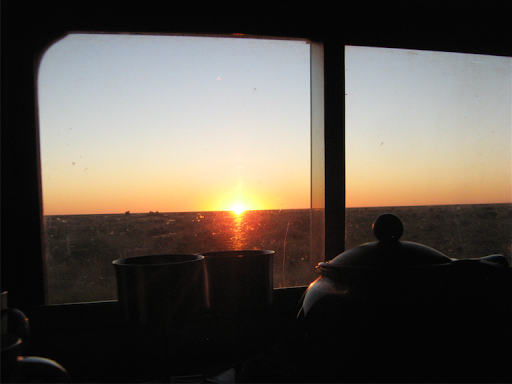
Today we completed the Tanami Track to Wolfe Creek about 120km from the township of Halls Creek, which is close enough for practical purposes. We’ve been driving almost non stop for 6 days and covered 2400km.
Todays travels included more corrugated track:
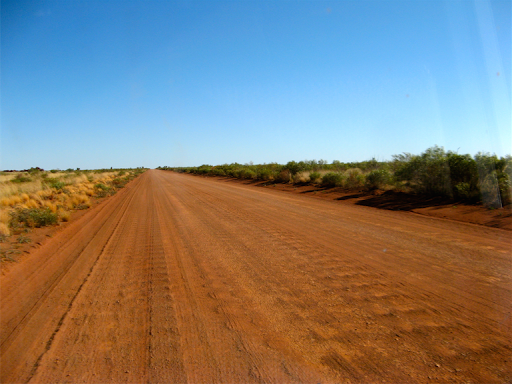
The Granites Gold mine, (this is as close as you can get):

The place where we collected a small termite mound for our garden in 2002. Janet thought it woeful that in 42 years of marriage we had only ever collected one termite mound:
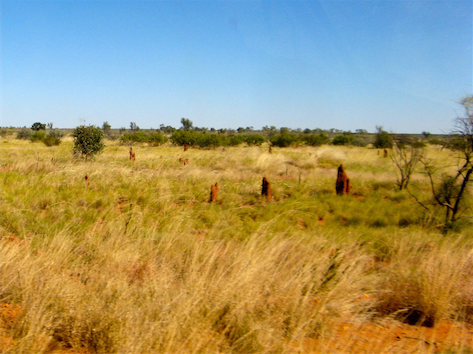
The exact spot where in 2002 we blew out a tyre on our LandRover.

And the top of the Canning Stock Route that we went down in 2007. If you go far enough south it comes out in Willuna, 1900km and 1200 sand dunes later, not a track for the feint hearted.

The WA/NT Conundrum.
We had lunch at the border between WA and the NT surrounded by “Welcome to WA and NT signs”.
However on the map as this GPS plot shows, the border is actually 2 1/2 km west of this point:
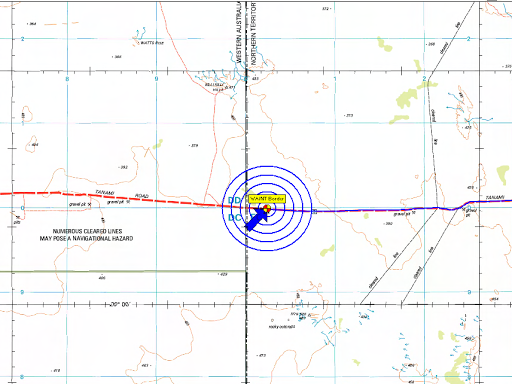
The GPS can’t be wrong and if the maps were not properly calibrated all our other positions would be wrong too, which they aren’t, I tried several different maps. So our only explanations are that either the maps are drawn with the border in the wrong place, which is unlikely, or all the signs have been put up in the wrong place. But something is definitely wrong..
We made contact with Dave on the radio who is visiting friends on Jubillee Station near Fitzroy Crossing. Tomorrow we’ll meet up with Deano and Kaye in Halls Creek and together we’ll meet up with Dave and Pauline on Tuesday for our attempted crossing of the Great Sandy Desert.
Some of the tracks do or did exist, some we’ll have to construct but others have done it before and we are collectively sensible, experienced and well equipped travellers so we will know when to backtrack or change our plans as necessary.
That completes the first part of our 2014 journey but you can follow the other sections of our 2014 trek here:
Northern Highway to the McLarty Hills
McLarty Hills to the Dragon Tree Soak


